








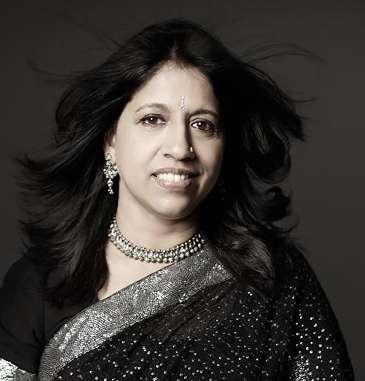




FOUNDER AND EDITOR-IN-CHIEF SEEMA KUMAR
CREATIVE DIRECTOR
SAJID MOINUDDIN
@seemanetwork
@seemanetworks
@seemanetwork
ON THE COVER: SUNEERA MADHANI (PAGE 40).
PHOTO CREDIT: THE BRANDED BOSS LADY
EDITORIAL COORDINATOR
ROHINI KAPUR
EDITORIAL ASSOCIATE AHAD SANWARI
WRITERS
ABHIJIT MASIH
PRATIKA YASHASWI
BINDU GOPAL RAO
RASHMI GOPAL RAO
SUGATO MUKHERJEE
SWETA VIKRAM
FARZANA SURI
BRAND PARTNERSHIPS, DEVELOPMENT AND STRATEGY
ANJALI MANIAM
SEEMA™ ISSUE 10 | OCTOBER 2022
EMPOWERING SOUTH ASIAN WOMEN GLOBALLY
SEEMA KUMAR, FOUNDER COPYRIGHT © 2021 SEEMA, JAYARAM, LLC SEEMA.COM
PUBLISHED AT P.O. BOX 814, PENNINGTON, NJ 08534
SUBSCRIPTION INQUIRIES: INFO@SEEMA.COM OR SEEMA.COM/ARTICLE/CONTACT-US TO SUBSCRIBE WRITE TO: SUBSCRIBE@SEEMA.COM
SPONSORSHIPS, PARTNERSHIPS, ADVERTISING, NEWSLETTER AND EVENT INQUIRES: INFO@SEEMA.COM FOR MORE INFORMATION ON ADVERTISING EMAIL: ADVERTISE@SEEMA.COM
ctober is one of my favorite months of the year, partly because it is when I have my birthday. But also because it is a month full of festivities celebrating traditions around the world. With the days getting increasingly shorter and cooler, we seek warmth, comfort and more time indoors with family and friends. Summer is gone, but fall fun has just begun.
In the United States, it’s time to go apple and pumpkin picking, while enjoying the crisp fall
Oweather and the beauty of leaves changing color. Already kids are looking forward to dressing up for Halloween, going trick or treating, and eating candies. Of course, beer lovers are looking forward to celebrating the German tradition of Oktoberfest, drinking loads of beer, and eating bratwurst.
For South Asians, October brings two festivals celebrating the victory of good over evil. The first is Dussehra, which falls on October 5 this year. According to Hindu mythology, Goddess Durga defeats the terrifying buffalo demon Mahishasura, restoring justice and peace in the world. On October 24, we celebrate Diwali, the festival of lights. It is by far the biggest Hindu festival of the year, one celebrated all over the world. It marks the
victory of good over evil, light over darkness, and knowledge over ignorance.
This month, as always, SEEMA highlights extraordinary women, pioneers who have blazed the trail in fields like fintech, music, technology and more. Our cover star is Suneera Madhani. She is the co-founder and CEO of Stax, a subscription style merchant service start-up that gained a $1 billion valuation in March. The 30-something Madhani is the daughter of Pakistani immigrants, and her incredible life inspires many who look like us. We also sit down with Kavita Krishnamurthy, the legendary Indian classical and playback music artist. An incredible vocalist who has recorded more than 50,000 songs in almost 50 languages, she is and is the recipient of India’s fourth-highest civilian honor, the Padma Shri. Plus, we talk to filmmaker Kauvery Kaul, designer Tina Tandon, and Tanvi Gupta, CEO of a new dating app called SwoonMe! And so much more.
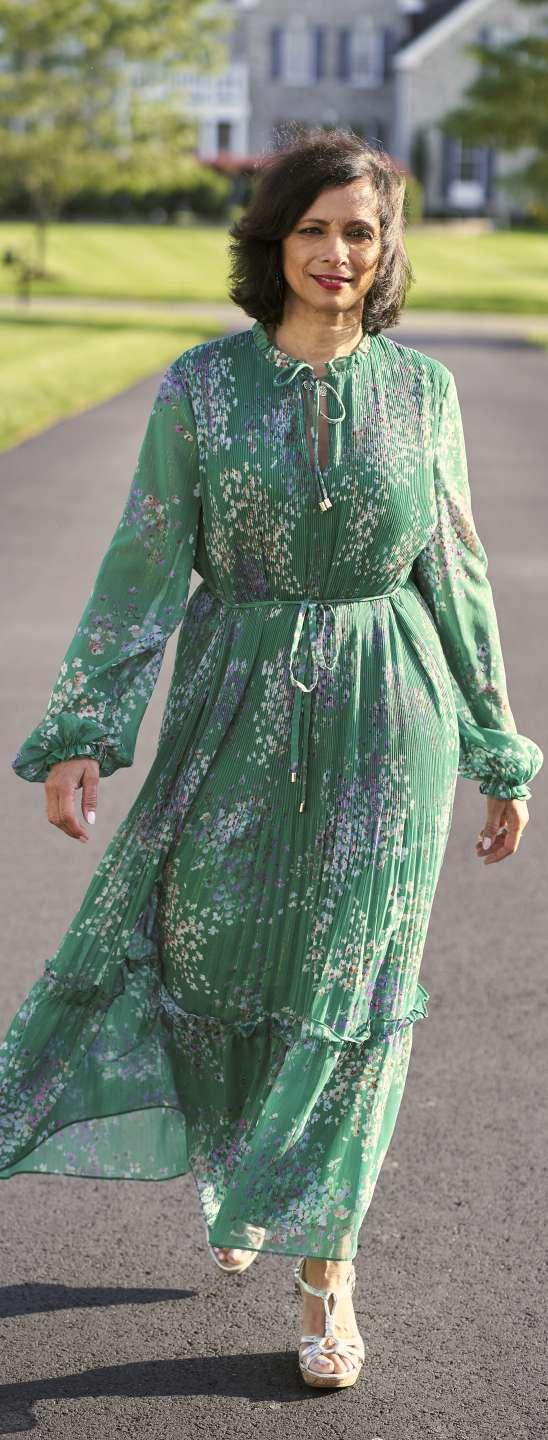
No Diwali celebration would be complete without a sumptuous meal, and we’ve got something special for you. Three of India’s top chefs have put together a choice three-course meal you can make at home – one that is healthy to boot! And our columnist Sweta Vikram reflects on the real meaning behind Diwali, and the importance of gratitude and of lighting up someone else’s life through giving.
Finally, we wind down after the hubbub of celebrations by taking a relaxing road trip and enjoy the fall foliage and quiet time to reflect on nature’s bounty and what we must do to protect and sustain it.
PHOTO CREDIT: SHRAVYA KAGTheSEEMA Network congregated September 14, 2022 at the Delhi Art Gallery in Manhattan, New York, to celebrate the power of leadership and female empowerment with the SEEMA Sisterhood Salon.
Surrounded by art created by eminent and under-appreciated South Asian artists, the salon featured a candid discussion on ways women can come together to tell each other’s stories and lift each other up.
The discussion was spearheaded by a panel of three eminent speakers: author Chitra Divakaruni; activist, actress, and author Nandana Sen; and nonprofit founder and lawyer Reshma Saujani.

The three women discussed how tales of women have been told through historical literature, such as Divakaruni’s, as well as
contemporary works, such as with Sen and Saujani.
We were joined also by Kavita Mehra, the executive director of Sakhi for South Asian Women, who touched upon topics of gender-related abuse and justice, particularly among members of the diaspora.
Founder and editor-in-chief Seema Kumar moderated the panel and also announced the SEEMA Network’s brand new leadership initiative.
A speaker’s bureau, as part of the initiative, was announced to provide a platform for women in executive positions the opportunity to confer and share their thoughts and experiences for the betterment of the community.
Attendees mingled over appetizers and cocktails, and got to purchase Divakaruni’s latest book, “The Last Queen,” and Sen’s translation of her mother’s poetry, “Acrobat.”

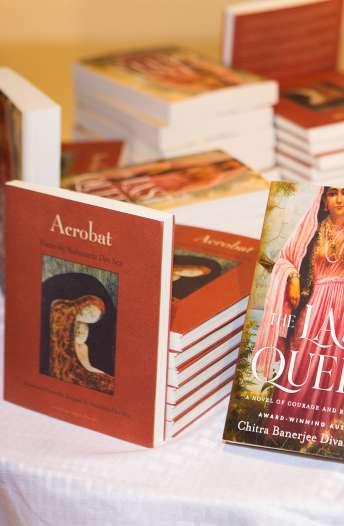
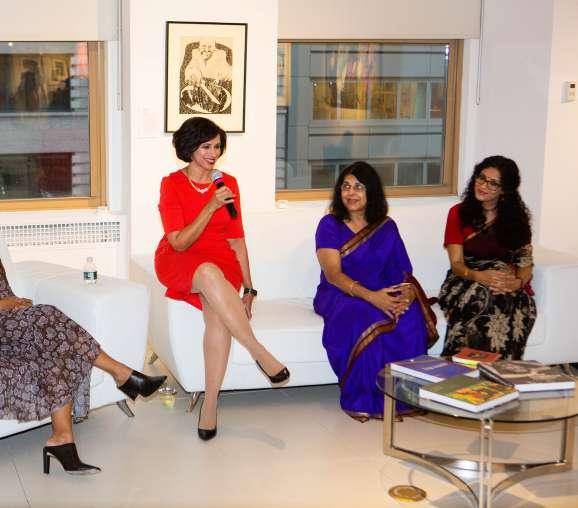



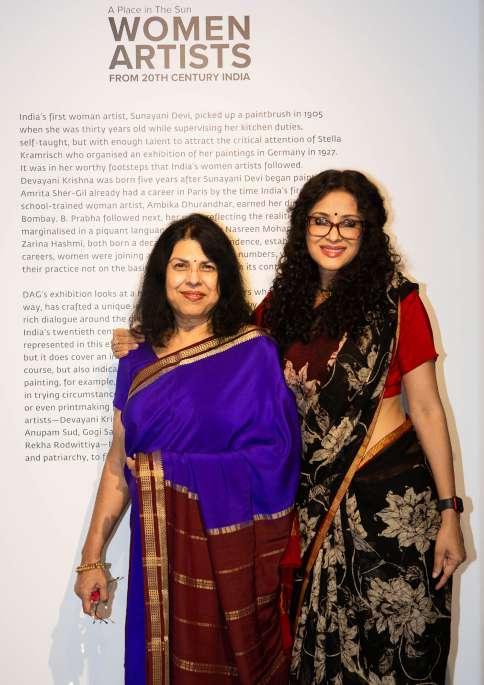

 CREDIT: SHARMEEN CHAUDHARY
CREDIT: SHARMEEN CHAUDHARY
Indira Bishen does justice to the traditional embroidery, and helps rural women artists in the bargain
After a successful debut at the South Asian New York Fashion Week early September, Indira Bishen LLC held an exhibition in Princeton, NJ last Sunday. The goal: spreading awareness and promoting the ancient art of chikankari through modern wear.


Designer Indira Bishen, who is originally from Lucknow, came with the idea after she found challenging to find hand-
embroidered modern chikankari clothing in the U.S. Her collection offers both traditional Indian wear as well as chic Indo-Western attire for all occasions. She aims to empower both the women who wear her line as well as those who create it.
Every Bishen piece is intricately crafted by female artisans in rural India seeking financial independence.
Follow her on Facebook and Instagram @indirabishenofficial to stay updated on her latest collections and future events.
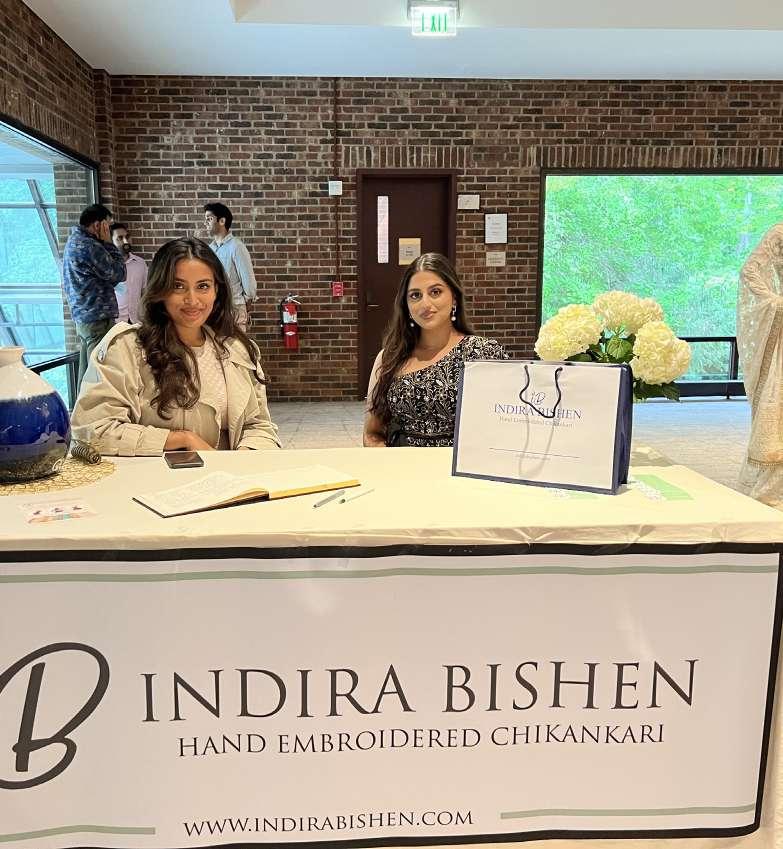

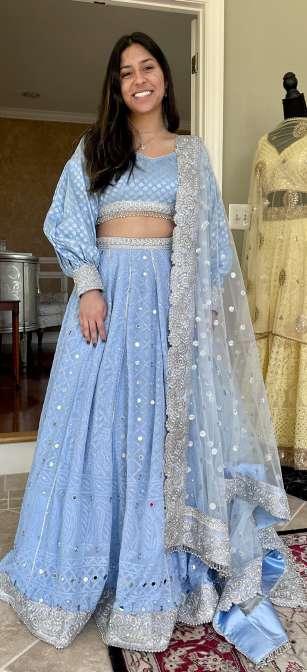

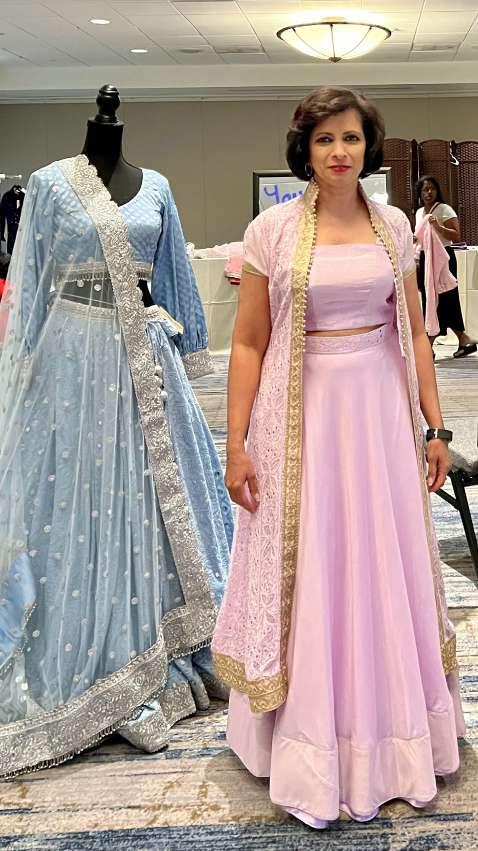
September 8 to 14, Manhattan glowed with ensembles from South Asian designers presenting their collections at South Asian New York Fashion Week (SANYFW). Headlined by some noteworthy names in international couture such as Nomi Ansari and Mayyur Girotra, this brandnew platform put the spotlight on South Asian fashion designers.
Some of the established designers who presented include Rivesse (Ishan Sanghvi),
Margi Official (Margi Sutaria), and jewelry by ReeMat Designs (Reena Mathur) and Avigna (Deepti Mandhava). Meanwhile, the emerging designers who showcased their collections included What is Moire? (Sezan Khan), Bedi NYC (Alice Narang), RKJ Designs (Renee), Aariah by Sabbineni (Harika & Anusha Sabbineni), Ayla Noor New York, Tai by Studio 9696 (Tupili Andrapathy Sandeep), Recover Season Co. (Reshma Zaman), and Pali (Vinod Muralidhar).
SEEMA offers a peek into the most compelling moments and stylish trends from SANYFW.
 PHOTO CREDIT:
PHOTO CREDIT:
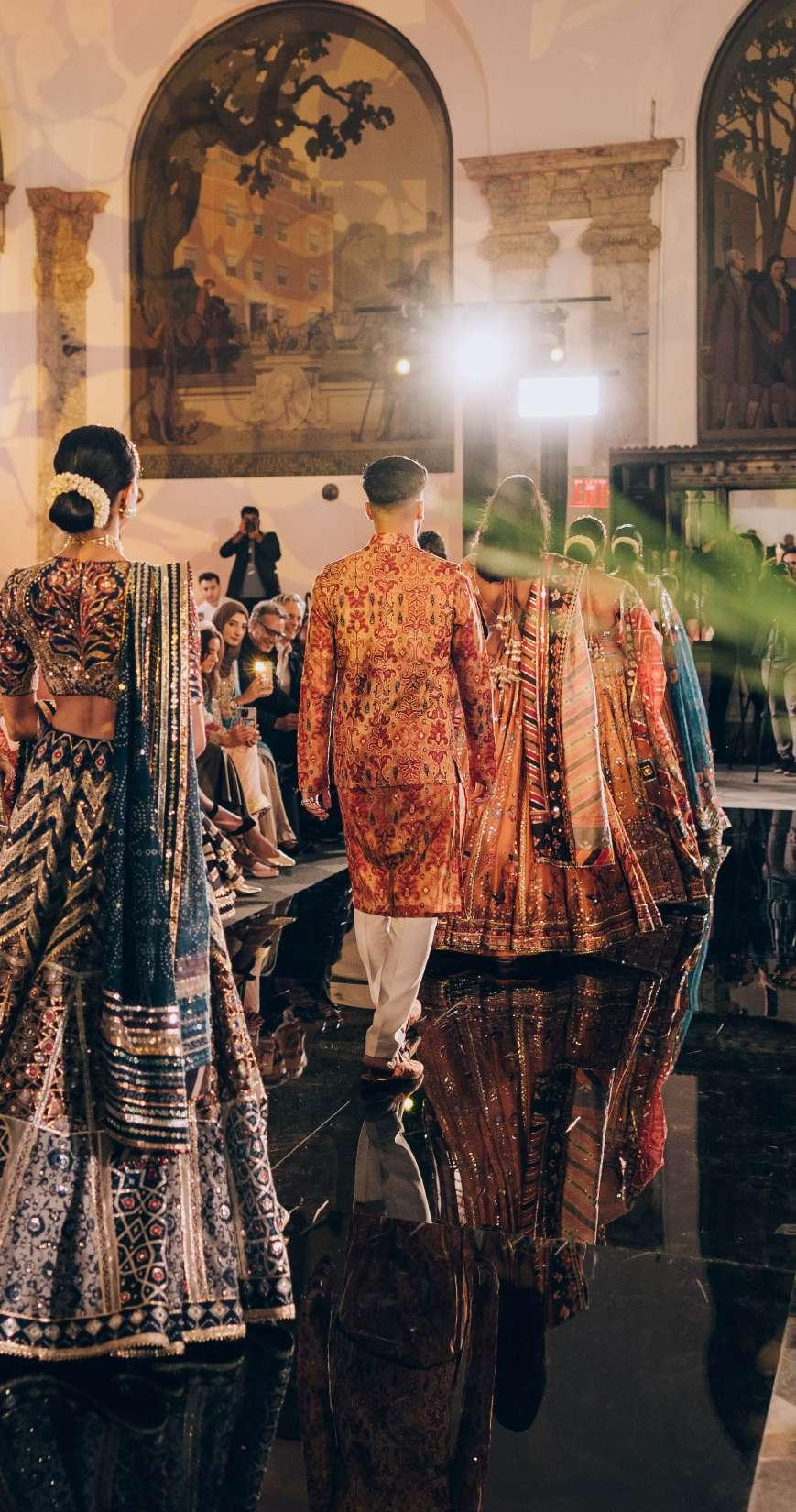
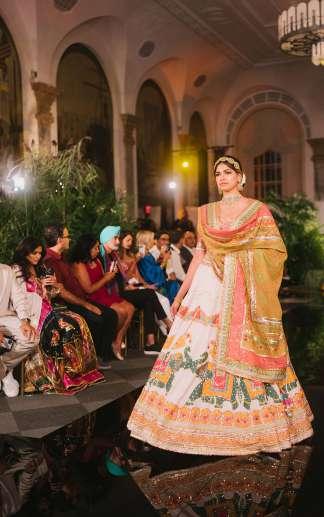
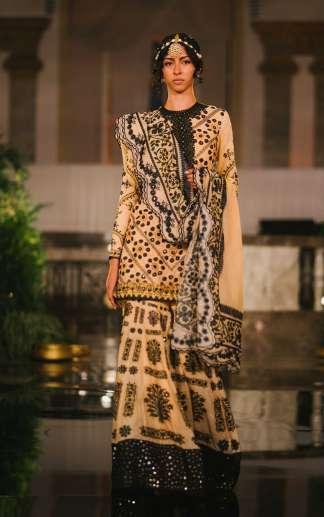













 PHOTO CREDIT: SWAPNIL JUNJARE FOR SANYFW
PHOTO CREDIT: SWAPNIL JUNJARE FOR SANYFW





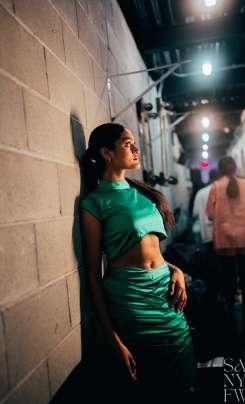




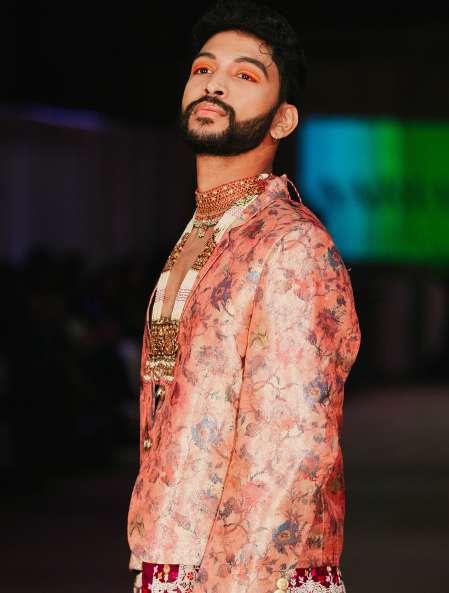


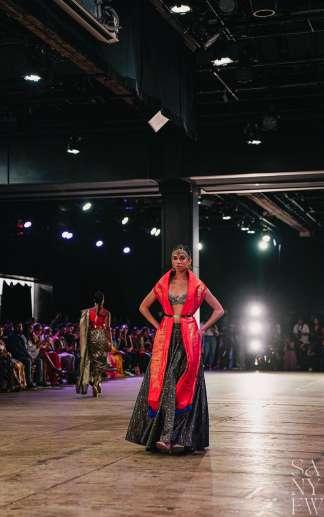
 PHOTO CREDIT: SWAPNIL JUNJARE FOR SANYFW
PHOTO CREDIT: SWAPNIL JUNJARE FOR SANYFW



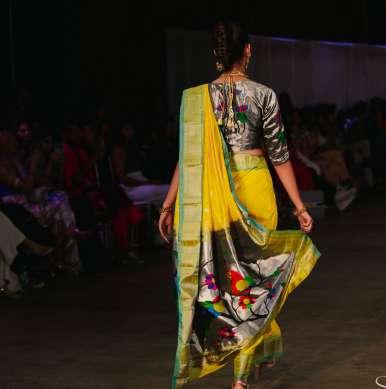


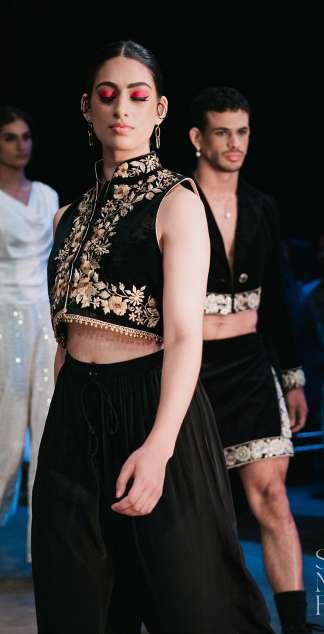


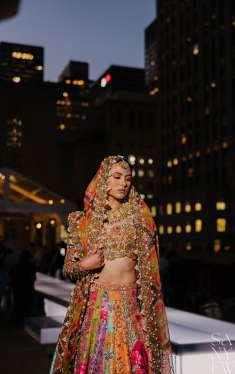

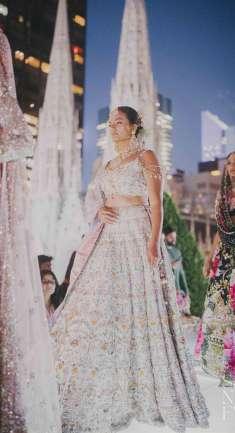

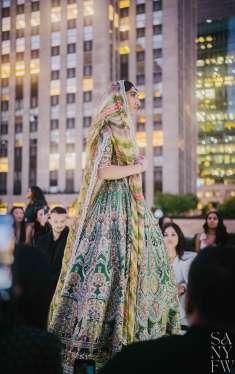




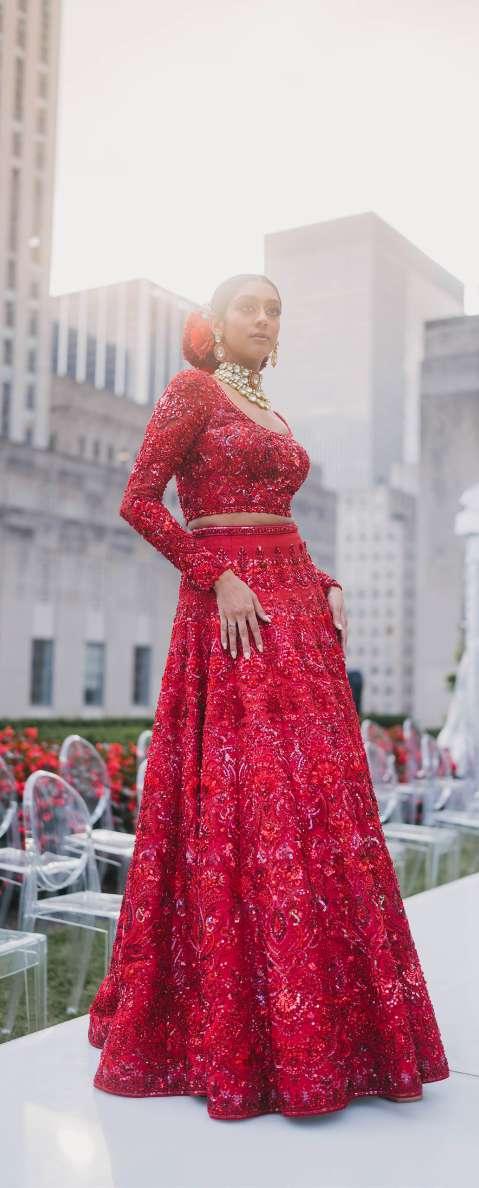
 PHOTO CREDIT: SWAPNIL JUNJARE FOR SANYFW
PHOTO CREDIT: SWAPNIL JUNJARE FOR SANYFW








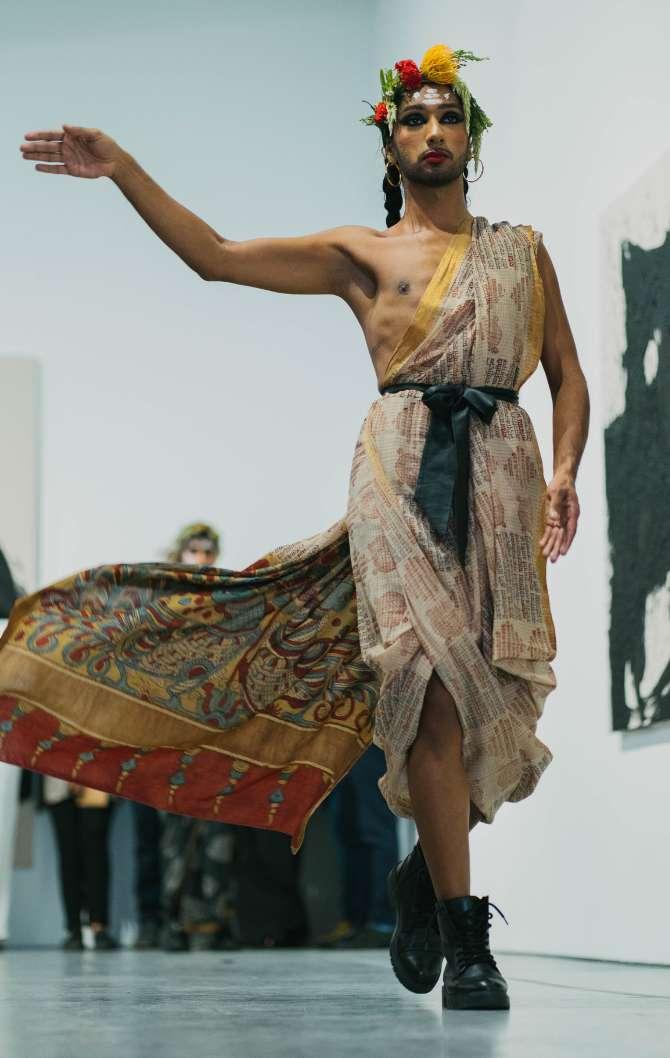
Whenaward-winning fashion designer Tina Tandon began designing clothes, fashion didn’t have much to offer the young Indian American woman.
“It was all old stuff that stores would get from Delhi and all that,” she says. “Everything was so outdated in the U.S. I wanted to create something that I can relate to as a young Indian American.” And so began Posh Pari Couture, a brand she describes as “Bollywood meets New York streets.” After a career working with brands like West Elm, Christian Lacroix and Escada, Tandon became one of the first designers to create Indo-fusion wear, an amalgam of Indian and Western design, way back in the 2000s. She was also one of the first female Indian American designers selling mainstream in the US at top designer stores,
under her eponymous label, T.TANDON.
Tandon has dressed a glittering clientele including Padma Lakshmi, Taapsee Pannu, and PV Sindhu, among many others.
Every season, 85-90% of the T.TANDON collections are made of natural fabrics using ecofriendly production processes; and a percentage of her profits from both T.TANDON and Posh Pari Couture go to charities benefiting underprivileged children in impoverished areas in India. In addition, Tandon supports women-run businesses and works with organizations that help provide livelihood and empowerment to women in small towns and villages.
SEEMA sat down to chat with the fashion pioneer to learn more about her work and the thrills and challenges of running a socially conscious line in an increasingly connected world.

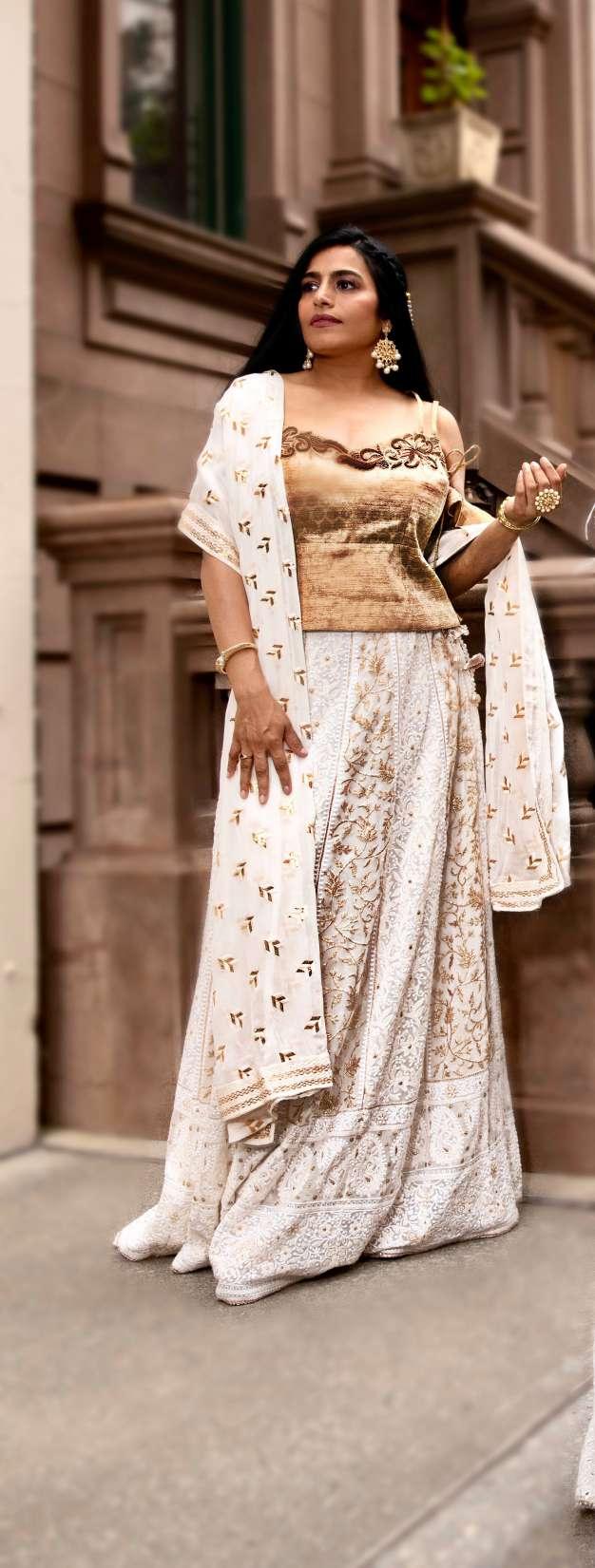
“FOR THE FUTURE OF FASHION, I THINK A LOT OF DESIGNS ARE BECOMING ANDROGYNOUS INTERNATIONALLY, THERE’S MORE BLENDING OF THE MALE AND FEMALE COLLECTIONS.
ELEMENTS FROM BOTH WOMEN’S AND MENSWEAR ARE BEING BORROWED FROM EACH OTHER - PINK SHIRTS FOR MEN, POWER SUITS FOR WOMEN, DRAPING IN MEN’S, MENSWEAR FABRICS FOR WOMEN, AND SO ON.”
When I was growing up in North Carolina, there wasn’t much diversity and they didn’t have a lot of Indians. I was subjected to a lot of bullying through school and they used to pick on my clothes. So that kind of made me pay a lot more attention to fashion in general. Then, I started taking design courses in high school and ended up making something like a pair of pants that was really ahead of its time. I wore it to school one day and it became the talk of the whole school and everybody loved it. It changed my whole image and all of a sudden, I became the cool kid.

I tried to change the adversity I went through into something positive and it took me where I am today. I went on to the Fashion Institute of Technology (FIT) on scholarship and the rest is history.
One of the things that really stands out in your work is that you’re very fond of the vintage aesthetic. How do you use vintage aesthetic in the sense be inspired by it, but also maintain a very modern interpretation of it?
I love the fashion from the 20s and 30s. At FIT, the more I studied the fashion, the more I got influenced by some of the amazing designs from the earlier eras.
I take some elements from that period, see what’s happening in the world today, and I mix and match. When I see some references from the past, I just close my eyes sometimes, and something appears on its own. It’s like my mind is programmed to just spit out new designs, just combining everything that’s already in my head.
Right now, you currently design for two different brands that aim at completely different customer profiles. You have the T.TANDON line, and you also have Posh Pari Couture. So how do you manage that creatively?
Since I’ve grown up in India and also in US, I take in cues and references from both cultures. And also, living in America, we have a need for both different parts of our lives. So
for the Western part, we need to go to galas or parties or events, and then there are the Indian parties, events and weddings and things. I realized I needed to design for both sides of our lives. There are two different worlds. So that’s why I have two collections. And when I don’t see anything I like out there, then I like to design it.
Tell us how you began your first fashion line. I always knew I wanted to have my own business. When I was working in the industry, I was keeping in mind that I was learning so I could be able to launch my own brand. So when I worked for Escada and Christian LaCroix in different capacities (I even helped launch West Elm, which is a huge home furnishings company), I was gathering knowledge on how businesses run, so I could eventually create my own business and my own brand.
So how was your business received at the beginning? It was great. Even my other friends who were not Indians started asking me for designs. That’s how I launched the other contemporary line (T.TANDON). It was great


Singer Falu Shah and danc er Drisya Reghuram in a recent photo shoot for Posh Pari CoutureDancer Drisya Reghuram and actor Ami Sheth in Posh Pari Couture ensembles
because at that time, there wasn’t anything like it and people were loving the new concepts, and it was something new and fresh. A couple of models who used to work for me went on to create their own fashion lines, so I guess you could say that I’m like a pioneer in this field, in US. Now we have a lot of variety, but earlier there weren’t many options
You’ve grown up in the US and India both, and you’ve also worked with a lot of global brands. How has this global background influenced your aesthetic today?
Both cultures influence each other. I get inspired by all these amazing handcrafts from India and then also the silhouettes and the construction that we learn from the western world. I always try to merge the two from my two different understandings of both the worlds, and it just creates something different and new.
What are the unique challenges of running a line that’s sustainable? What could be easier about it? It is a bit challenging because you have to find materials. My concern is, fabrics like polyester don’t biodegrade. And then they just lay in landfills forever and ever and pollute the earth. So, we use natural fabrics or dead stock from leftovers. But at the same time, I don’t want to compromise on design aesthetics because most of the sustainable brands, if you think about it, have very plain and simple looks. I didn’t want to do that. I want to create a high fashion brand that is still sustainable. So we keep in mind how we can be more conscious of the world. We try to be fair trade and also give a percentage to help the women in India. Yesterday I was helping an NGO that trains women from underprivileged areas like slums in things like sewing and salon beauty services so they can go on to get their own jobs or work for themselves.
That has been part of our mission, and that’s for both the brands. While it’s challenging to source
fabrics, there’re a lot of great options coming out. Mostly we use silks, cotton, linen fabrics that are biodegradable. And then there’s lotus fabric, modal, bamboo fabric, things like that. Soon we’re going to incorporate some fabrics synthesized from 100% milk.
Could you tell me how you see the future of fashion in terms of aesthetics? If there are some trends that you’re picking up on that might shape the future of fashion, what are they? For the future of fashion, I think a lot of designs are becoming androgynous internationally, there’s more blending of the male and female collections. Elements from both women’s and menswear are being borrowed from each other - pink shirts for men, power suits for women, draping in men’s, menswear fabrics for women, and so on.
As for current trends in Indian collections, we’re seeing a lot of ruffles in saris and lehengas, and shararas, too. Dhoti-style skirts, pre-draped saris, tulip pants and shararas are pretty strong right now, paired with a peplum blouse or short choli blouse and a jacket or a cape. Look out for these styles for the festive season!
Color like pink, fuschia, yellow, mustard are also really strong right now.
Globally speaking, we’re all blending more and more. So, for instance Indo-Western design is pretty strong internationally. I think in the connected world, the lines are getting more blurred between different ethnicities and cultures and their influences.
The festive season is coming up. Do you have any style recommendations for women getting decked up for this festive season? I would say just one should go with their own personal style and keep in mind that sometimes the trends don’t always work for everybody. They have to go with their body shape and see what shapes and silhouettes work best for their body. And of course, wear anything that makes them feel beautiful.
MAKEUP: ANNETTE BRAGAS @ANNETTEBRAGASMUA
HAIR: KANWAL BATOOL @IAMKANWALBATOOL
STYLING: TINA TANDON @TINATANDON_OFFICIAL OUTFITS: POSH PARI COUTURE @POSHPARICOUTURE
FALU SHAH: GRAMMY AWARD WINNING VOCALIST, COMPOSER AND EDUCATOR @FALUMUSIC AMI SHETH: NATIONAL TV FEATURED ACTRESS (DIETLAND, BLINDSPOT) @AMISHETH DRISYA REGURAM: DANCER, CHOREOGRAPHER, CONTENT CREATOR (TIKTOK 1 MIL +), INSTA (OVER 10 MIL VIEWS)
@DRISYAREGHURAM
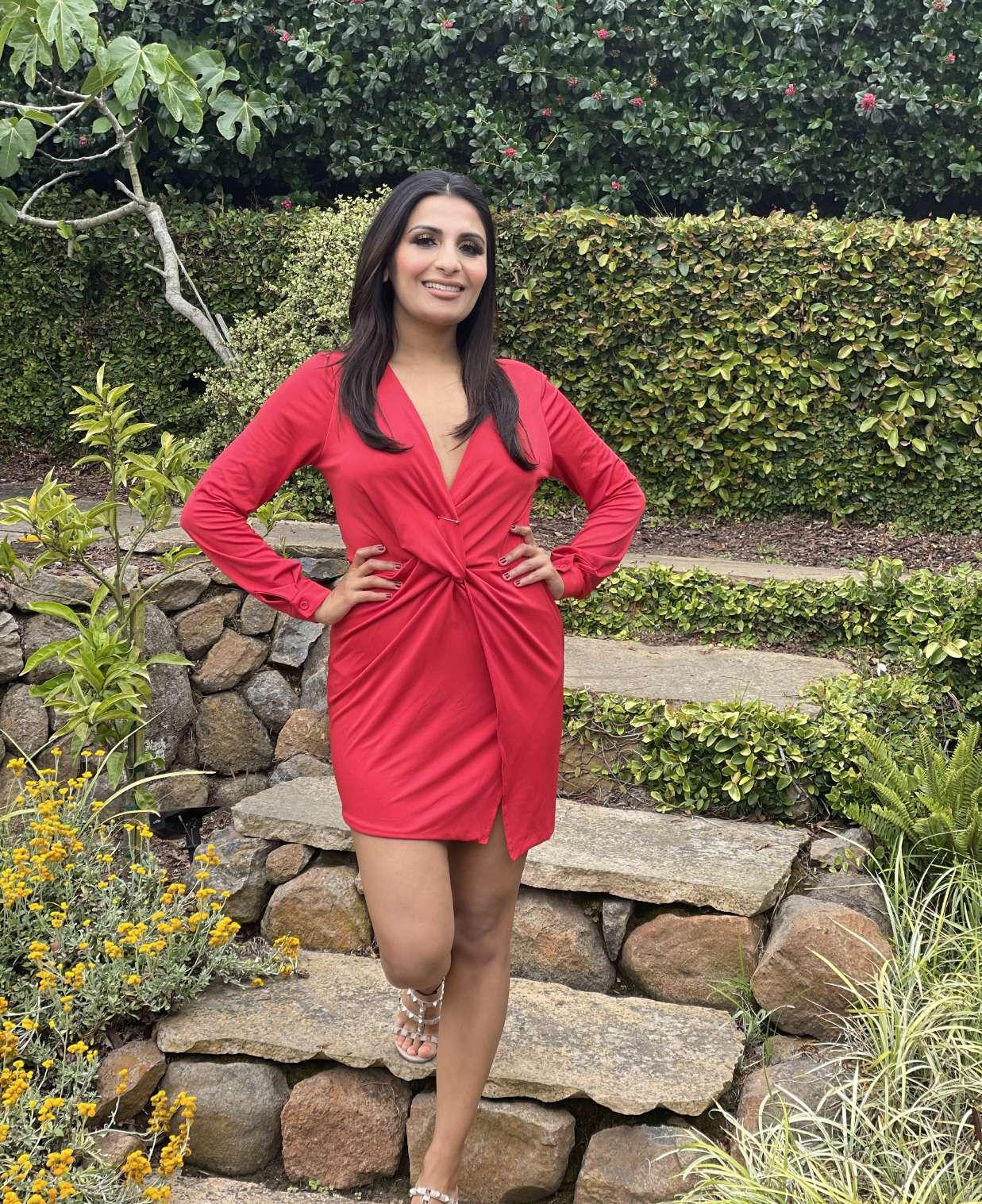 Tanvi Gupta, founder and CEO of SwoonMe
Tanvi Gupta, founder and CEO of SwoonMe
The dating experiences of Tanvi Gupta, a former product manager at Meta and the founder and CEO of SwoonMe, led to the idea of a voice-first dating app. Gupta says she hopes to help people experience those butterflies in the stomach through SwoonMe, an idea for a startup that came to her when she fell in love.
Numerous other dating apps are picture-based, where you look at one or few images of people and make split-
second decisions. SwoonMe, Gupta’s brainchild, gives you the ability to conceal your identity behind an avatar until you feel confident enough to reveal your face to the other person. It harks back to old-school romance and courtship, which often began with a simple conversation. It allows for the joys of experiencing those butterflies in the stomach, provides mystery and intrigue, and lets one form a mental sketch of the person behind the voice.
Gupta moved to the US from Patiala when she was just 16 and studied at
Carroll University before doing her MBA at Marquette University. She moved to New York City and worked in a few financial institutions on Wall Street till she met her husband, Vivek, a techie from Silicon Valley, on a night out with friends. Before she met Vivek, she followed the common method of finding a date – swiping her phone. She had about eight or nine dating apps on her phone at that time. The only thing bothering her was the constant pressure of looking good. Not that it’s a bad thing. Obviously, everyone wants to look good, but she found it gross to be judged in a split second. She didn’t want to be judged solely
on physical appearance. Thus the idea for a voice-first avatar-based dating app came to her. She spoke to SEEMA about her journey.
You moved to the US when you were just a teenager, tell us about the time and your education? I moved here on my own. I did not have any relatives in Wisconsin. Still not many Indians there, mainly a very White place. I went to Carroll University and then I got my MBA in Wisconsin as well – from Marquette University. And after that, I moved to New York City to work on Wall Street. Now my family comes here to

visit. My brother is here with me, who is also the cofounder and CTO of SwoonMe. My parents visit. My mom has actually been here for six months now.
It must have been a challenge, coming here at that age, trying to adjust, to find your identity? I came, actually to the dorm. So it’s wasn’t like, I have to go buy my housing, food and things like that. I came to like a typical American experience of being in dorms with other girls. I was just excited. I’ve always been very open to new things and doing things out of my comfort zone ever since I was young. I see that has played out throughout my life. It just feels like it’s a way to grow. Not that I was thinking so deep at that time, was just exciting and fun getting out of the house. I think it was a little bit of a hard adjustment when it came to food. But I made friends like very quickly. There were a lot of international students from other countries. It didn’t feel hard in terms of finding friends, but it’s a little bit of adjustment, when you go out of your home.
From Wall Street you moved to Facebook. Tell us about working for Meta?
I had been at Wall Street working for big banks. And then I was a consultant briefly, again, at banks and then I worked at Meta for three years. I had been on Messenger, and Instagram direct, purely on the consumer side, building products, understanding what our users want, the psychology of why they use this, how should they use this? What should we build, all of that, very much product oriented. The most instrumental fun experience that I’ve had in my career was at Facebook. It is a dream job if it works for you, and it was working for me. Really loved it.
Leaving the dream job at Facebook must have been a massive decision, a risk perhaps. So what made you do it?
I’ve always want to get out of my comfort zone and grow. I felt like I wanted to do something of my own because when I would listen to Zuck (Mark Zuckerberg) speak, when I would listen to his Q and
A’s and how Facebook operated and how he started, I really would get inspired. I just felt, when you create a company, you do a startup or whatever you start, there’s bound to be mistakes. Nobody knows until you do it practically, until you do it right.
Meeting your husband and those initial days of courtship led to the idea of SwoonMe. Tell us how you met Vivek and how it led to the formation of your company?
I actually met my husband. In New York City, I was out one night, you know, after work, and he was also out. We just exchanged numbers after having like a nice conversation and sharing a drink. And then we started talking on the phone. Interestingly, like a lot on the phone! When he went back to California, it really started when we were talking on the phone. That’s when I felt that a voice-first platform made sense. It was never really about exchanging photos or anything like that. It was just like really connecting, based on shared ideologies. There’s so much you can learn about a person through the voice. It contributes to enhance dating, real life like experience. So, like, I’m talking to you on the phone right now. And you could tell so much about me, right? And as I’m talking I get to know so much about you, I feel like I want to keep talking to you, somebody I want to share things with.
You mentioned you used to have a number of dating apps on your phone. What does SwoonMe offer that sets it apart from all the others? All other dating apps in the market right now –the leading players – like Bumble, Tinder, Hinge, OKCupid – they’ve been around for so long and they are all picture-based. You take one photo or a few photos, some may be filtered, and people are just looking at that and making their split-second decision. But SwoonMe is a voice-first Avatar based dating app that creates an opportunity for singles to date in the metaverse. Sure, love is blind. But I also know from that there are some people that have certain requirements when it comes to comes to
A glimpse of SwoonMe
finding a mate. So I thought we have to show some aspect of somebody’s face. An avatar could tell a lot about a person’s appearance, just not everything. There is some element of mystery. We want to be just like in real life that you would meet somebody at a party, at a bar, in a workplace. The Avatar is actually an opportunity for Swooners to visualize one another without being superficial or judgmental. They can even personalize these avatars, which can be quite fun.
Is the app free? Right now the platform is totally free. That’s because we wanted to build critical mass before we monetize. We have a really good product. Our engagement is about 18 minutes per day per user on the platform. Our retention is pretty great – 30-day retention is at about 20%, which is pretty great for a dating app.


“YOU TAKE ONE PHOTO OR A FEW PHOTOS, SOME MAY BE FILTERED, AND PEOPLE ARE JUST LOOKING AT THAT AND MAKING THEIR SPLITSECOND DECISION. BUT SWOONME IS A VOICE-FIRST AVATAR BASED DATING APP THAT CREATES AN OPPORTUNITY FOR SINGLES TO DATE IN THE METAVERSE”
Right now, we are raising funding so we can scale in terms of organic as well as add the ad based users.
Which have been the countries that have been most receptive in terms of your base of Swooners?
We haven’t actually launched globally; we’re just working on smoothing a couple of different things. Then we plan to launch mostly in all Englishspeaking countries. But we are live here in the U.S., Canada and India. The most receptive people are in the U.S. and Canada, the reason being that people are very open and not hesitant to record their voice because there’s no language barrier. English is their first language, whereas in India, people are hesitant to record their voice notes in Hindi or their native language. They want to do so in English and they may not speak it so well.
Women are afraid of stalkers. They’re afraid somebody will come out to them, or get to know their profile, or that their families might get to know. Women in India are uploading – on these other picture based platforms – things like leg photos, pictures of [actor] Katrina Kaif. We [at SwoonMe] give that security because it’s so private and safe. They can generate an avatar and then we give them the option to reveal an avatar during a one-on-one chat. That actually empowers female users to find love, while maintaining privacy and integrity of their identity. And we take integrity issues very seriously, like protecting users from spam, reporting bad profiles, and we do a lot of back-end work to analyze profiles and remove bad actors. This platform actually works for women, because of the safety and privacy that we provide that other platforms do not at the moment.


Havingsung almost 50,000 songs in 50 different languages, Kavita Krishnamurhy is a legend in both Indian classical singing and Hindi film playback music. Some of her chart-topping numbers have been from films like “Mr. India,” “1942: A Love Story,” “Devdas” and “Hum Dil De Chuke Sanam.” Her Unforgettable songs include “Hawa Hawaii,” “Pyar Hua Chupke Se,” “Dola Re Dola” and “Hum Dil De Chuke Sanam.”
She took out time to speak to SEEMA from her busy schedule while touring the U.S. with her husband, the legendary Dr. L. Subramaniam. The tour was to celebrate 75th year of India’s independence through the musical piece written by Dr. L. Subramaniam called
Mahatmas Symphony performed in association with the Houston Symphony Orchestra. Krishnamurthy shared her journey, which started in Delhi and which was built on the shoulders of two women – her mother and her Mamuni – who held her hand during the initial struggles in Mumbai (then Bombay).
Krishnamurthy described working with the great singers and music directors of the 70s and 80s, including Lata Mageshkar, Kishore Kumar, Mohammed Rafi, Laxmikant Pyarelal, R. D. Burman, Ismail Durbar and A.R. Rahman. She talked with awe of their musical genius and inspiring humility. She also revealed the special bond she shares with Hema Malini and the impact the actor had on her life.
Krishnamurthy sang her first song in 1971 but the Filmfare award, the only industry prize in India at the
The ever-modest Kavita Krishnamurthy describes her amazing life
time, eluded her. Finally, she received it in 1994 for her work in “1942: A Love Story.” At the award function, Lata Mangeshkar, who was being conferred the Lifetime Achievement award, started her acceptance speech thanking Filmfare for finally recognizing the talent of Kavita Krishnamurthy.
Krishnamurthy chatted with us in a virtual interview (with a little technical help from Subramaniam), who helped her adjust the camera and the frame.
We all know your incredible repertoire, but we want to start at the very beginning and find out about your musical journey and your growing years. How did it begin?
For me, being a music professional is quite unexpected. I was born and brought up in a South Indian family in Delhi because my father was in government service. We were a joint family – [living there] along with a Bengali family. We were two families living together in the same house.

South Indian and Bengali families always encourage their children to learn either music or dance. I naturally had an inclination for music, and so did my brother. So we started learning music. And the very first [lessons were] in Tagore music – Rabindra Sangeet as they call it. We sang for competitions and won some prizes. Then we got a masterji who taught us Hindustani music. My mother felt that, being in Delhi, Hindustani
teaching would be better, [since it would be hard] to find a Carnatic music teacher. My brother and I sang for competitions and at All India Radio.
I wanted to have an exotic life. So I thought of joining the Indian Foreign Service and go to different countries. But my Bengali aunt, who was very close to the mother of Hema Malini, who had become the Dream Girl of Indian cinema, thought of taking me to Bombay as she saw playback singing as a future for me. I never thought anything [for myself]. I was probably one of those real obedient middle-class girls. I joined St. Xavier’s College. In the process many doors opened for me to sing.
The very first jingle that I did was with Geetaji [Geeta Dutt] for Amul Spray. Then cut to singing in college day function where Hemant Kumar is the chief guest. He invited me to sing on stage with him. There began my journey singing on stage.
He had to record a Bengali song with Lataji and asked me to come to the recording studio. I learned four lines of a Bengali song for a film called “Shriman Prithviraj.” That was in 1971. Once I finished rehearsing, I saw the door opens and Lataji walked in. That was the start of my career. I always feel it was with Lataji’s blessings that I started. By the time I finished graduation, I was busy with work, singing here and there. So somehow, my destiny was shown to me by God, and I think I just continued on this path for so many years now. It’s been 52 years now in music.
Kavita Krishnamurthy performs with her husband, Dr. L. Subramaniam, a violinist, composer and conductor

Kavita Krishnamurthy with singer Asha Bhosle
Kavita Krishnamurthy and her husband, Dr. L. Subramaniam with Lata Mangeshkar
“THERE WAS NO SHORTCUT TO HARD WORK, NO SHORTCUT TO SUCCESS; YOU HAVE TO BE SINCERE AND TRUE TO WHAT YOU DO. THAT WAS A GREAT LEARNING LESSON FOR ME”
You’ve had such a long and illustrious career, tell us about some of your most memorable songs, your favorites, and favorite musical collaborations. One of the greatest people I have sung with is Kishore Da (Kishore Kumar). I sang about seven or eight duets with him. All these people of that generation – Lataji, Ashaji [Bhosle] [Mohammed] Rafi saab – I really learned one thing about all of them: They had already sung numerous number of songs, but [it was wonderful] still to see them coming to the sets and treating that particular song as almost a first song. They were so dedicated in the way to say the words with a beautiful akaar. There were so many things to learn from that generation. They were perfectionists dedicated to their work, and all of them were very humble. I was a nonentity, but when I sang with them, not one of them treated me like a junior singer. This is what I learned that there was no shortcut to hard work, no shortcut to success; you have to be sincere and true to what you do. That was a great learning lesson for me.

Do you have any favorite and meaningful song of yours?
“Hawa Hawaii” was one of the most memorable songs –which I sang in 1986. It’s an item song or a fun song. But, believe me, it’s a song I can sing every day and still enjoy it. It is one of the nicest songs ever, and I have very good memories of the recording.
It wasn’t originally supposed to be my song, because it was a huge film of Sreedevi. I thought Ashaji would sing it but they actually kept it in my voice. I was absolutely so grateful for Lakshmikantji when he told me that everybody likes the song and they want to keep the version I had sung. I told him that I had made a mistake in the song, but the way Srideviji enacted it, every word looked as it [were intended]. This song has lasted for so many years along with that one word I said wrong in that song.
Mothers play such a huge role in shaping our lives and our value systems. I believe it was the same for you. Tell us a little bit about her and how she shaped your life and your musical career. In my life I’ve had two sets of parents – two fathers and two mothers. A Bengali mother and the mother who gave birth to me – a South Indian. She had learned Carnatic music but she got married when she was 14, and she dreamed that I should sing. She wanted to make sure that I learned music very well. So musically, she used to help me a lot.
My Bengali mother, who I call Mamuni, with whom I’ve had absolutely great bonding, she was not as musically sharp as my mother. But she had good sense. She’s the one who dreamed of taking me to Bombay and making a career. Mamuni took my hand and was a great strength for me in Bombay. She would go to the market, cook the food come all the way to Xavier’s [College]
From left to right: Singer Manhar Udhas, actor Hema Malini with her mother, and Kavita Krishnamurthyand then take me home. Sometimes she would take me to the studios straight from college for my recordings. She was such a support system for me, she was there for every song, and she was there for my first Filmfare award feeling so proud. So these two women never left me alone and they played a very big role in what I am. I have to say that Indian women are the best. That generation, they never asked for anything for themselves. Every time they were praying for the family. They were praying for my welfare.
You mentioned Hema Malini earlier and that you share a very close relationship with her. She even calls you Papa (baby in Tamil). Tell us a little bit about that special relationship and what she means to you. We grew up together. Nandita – my Mamuni’s daughter who speaks fluent Tamil – and Hemaji were best friends. They went for dance lessons. As a kid, sometimes I used to be dragged along for these dance lessons. They learned to dance together. One day Hemaji left Delhi to become the ‘Dream Girl’ of Bombay.
When I was based in Bombay she and her mother used to be very helpful. She was the one who took me to Laxmikant Pyarelal and told them that this girl was Hema’s cousin and you have to give her a break someday. One of the first songs of mine was for Hemaji and I sang for so many of her ballets. She has been like an elder sister. She has her fame as a top-notch actress [but] it made no difference to her relationship with me. She still

treated me with the same affection in those early days in Bombay. I could walk into her house any time and she and her mother would never let us go without food. They have been such a great family, and HemaI herself has been so affectionate, I’m grateful to God that I have people like her in my life.
You’ve worked with so many legendary musical directors from different eras, who do you think brought out the best in you as a playback singer? And who did you like working with the most?
My gurus are definitely Laxmikant and Pyarelal – and R. D. Burman after that. They absolutely are my gurus, and have a special place in my heart. I learned a lot about how to sing in front of the mike from them.
In the next generation [of music directors], I think one of the finest music directors I’ve ever sang for is Ismail Durbar. In “Devdas” and “Hum Dil De Chuke Sanam,” he gave me fantastic songs. Another phenomenal music director, who is one of the nicest people in the industry with whom I’ve had the great honor of working for, is A.R. Rahman. He is such a nice person and he has given me such good songs. His approach is so gentle. I would say that he has brought out the best in some of the songs that I have sung for him.
As an accomplished musician, performing artists, what advice do you have young women who wonder how to get there like you did?
First, I would say that to be a playback singer, you have to concentrate on your voice quality. You have to. You’re singing songs that’s not classical music. You’re singing the words, therefore, akaar has to be very good. The pronunciation of words have to be very good, very clear on the mic. My advice to children is, please don’t depend on a pitch corrector; make sure you strengthen your pitch. Finally, pick up a lot of different kinds of songs. It’s very important to emote a song well. Any singer should be able to sing a song with genuine emotion.
You’ve been touring the US with your husband and legendary musician Dr. L. Subramaniam. Tell us about the tour and its historic significance. This is pretty exciting for me because we wanted to do something special for the 75th year of India’s independence. My husband had started writing a piece called Mahatmas Symphony and we got the offer to do this with the Houston Symphony Orchestra in Houston. There are three movements. The first movement is totally
orchestral, and starts with Gandhiji, seeing the turbulence in South Africa, being thrown off the train and then how he moves to India. The second movement is essentially the national agenda. And the third movement starts with a little bit of the turbulence of the civil disobedience movement and the final interpretation of independence having been attained, the happy moments and the salute to motherland. It’s not the traditional tune but has been modernized to match the Western orchestra Symphony Orchestra plus the choir.
Dr. L. Subramaniam is such a legend, not just in India but globally. Tell us a little about him. I’m very happy that I have somebody like my husband in my life, because he is a pioneer in whatever he’s done. If you’ve seen the past, the very first North-South jugalbandi that ever happened – in the early to mid 80s – was in New York with Ali Akbar Khan sahab. He played the sarod and [my husband] played the violin. As a classical Carnatic musician, he was one of the pioneering people to do fusion music. Then [he did] the orchestral writing where he didn’t ask a Western composer to write the Western parts. He writes every note of the orchestra for every symphony… because he’s a master invested in music. He has actually shown a new path to the new generation of artists in India. He has shown what all we can do to take Indian music to the world stage. He’s been a pioneer in this field.
For me to work with somebody like him is wonderful because he never lets me stop. Finally, as musicians we have to remember, fame, money. Those are important things, I suppose, in life, but you have to do music for yourself. That’s what I learned from him. As a woman, to have a support system like that from a man at my stage of life is very important. You can’t do without it if you want to go ahead.
What are current and future musical projects you are working on?
After the U.S., we go to Europe. I’m doing Mahatma Symphony concerts in Madrid, Milan and Bolognia. Then, of course, there are a lot of songs in the offing. I did a couple of songs where I composed Meera bhajans. I put those up on YouTube and Facebook. I’m also looking forward to going back and composing my own songs, which my husband helps me orchestrate. For the Meera bhajans I did it with symphony musicians in Prague. Two of them have been released. I look forward to different things. As long as I can continue to sing for a few more years I’ll be happy.
“YOU HAVE TO DO MUSIC FOR YOURSELF. THAT’S WHAT I LEARNED FROM HIM. AS A WOMAN, TO HAVE A SUPPORT SYSTEM LIKE THAT FROM A MAN AT MY STAGE OF LIFE IS VERY IMPORTANT. YOU CAN’T DO WITHOUT IT IF YOU WANT TO GO AHEAD.”
 Kavita Krishnamurthy with her husband Dr. L. Subramaniam and children
Kavita Krishnamurthy with her husband Dr. L. Subramaniam and children
With Stax, her subscription-based payment platform, Suneera Madhani has broken into an exclusive club ABHIJIT MASIH
 PHOTOGRAPHER: ORLANDO BRAND PHOTOGRAPHER BY THE BRANDED BOSS LADY
PHOTOGRAPHER: ORLANDO BRAND PHOTOGRAPHER BY THE BRANDED BOSS LADY

It was one of those rare but intense snowstorms that sweep across Texas that did it.
Stuck in Dallas, and unable to return to Orlando, Suneera Madhani decided to spend time rerouting her subscriptions so she could continue to enjoy them when she finally got back. That’s when she had the a-ha moment for a subscription-based payment platform, the idea for her payment startup, Stax.
Madhani is the co-founder and CEO of the company, which attained a $1 billion valuation earlier this year.
The daughter of Pakistani immigrants shared with SEEMA how she grew up in the U.S., overcoming hurdles and


The Madhani family giving a nod to their Pakistani tradition and culturePHOTO CREDIT: SUNEERA MADHANI
achieving a lot nonetheless. Just in her 30s, Madhani helps other women find their voice and their place in the exclusive unicorn club.
Harking back to the day she had her great idea Madhani recalled, “I was actually visiting my nanima in Dallas and was trying to reroute my subscription based boxes. This is pre-subscription economy. That’s when the light bulb went off: Why isn’t there a subscription based credit card processor? So quickly I changed my flight to Houston, to pitch this idea to my bosses.”
At that point she had no intention to become an entrepreneur. She just passed on the idea to the fintech company she worked for but was not taken seriously.
“I was just trying to do what’s right by my company,” Madhani said. “I was excited about this idea. I thought this would really work in our industry – and for my company. I pitched the idea to an all-male team... and I got laughed out of the room. I was told that it would never work and that I didn’t have the experience to run it. I just left really disappointed.”
The men in Madhani’s family – her father and brother – thankfully were different from those in the boardroom. That very night, she discussed the matter with her family at dinner, where she decided that she didn’t want to work for a company that didn’t believe in her. Her brother, who was then working for a startup in California, was part of the discussion.
She remembered, “We were all together as a family. We were all around the family dinner table, and my dad goes, ‘Sonny, why don’t you just go do it.’” Madhani has that line emblazoned on office wall, a constant reminder for her to tell the world to bring it on.
“It was their push. And I said, I’m gonna go do it,” she added with pride.
Now, the entrepreneurial genes run in the family.
Madhani credits her parents for providing an in-house MBA at home for her brother and herself. Like many South Asian immigrants, her parents had little choice but to start a small businesses. Madhani learned all about running a business from them.
“I’m an entrepreneur today because my parents were entrepreneurs,” she said. “Today, being an

Suneera with Faisal - Best friend, proud and supportive life partner
Suneera admits that the greatest title that she canwear is that of being a mother to her two daughters

entrepreneur is sexy, it’s exciting and the whole world wants to talk about entrepreneurship and startups. They were entrepreneurs out of necessity, because they weren’t educated. They worked hard to provide my brother and me with an education. My parents owned convenience stores, gas stations and a pizza shop. And at one point, my father had a marketing company. It was this endless endeavor of businesses. My brother and I were always involved in the family business and had responsibilities.”
Under Madhani’s leadership, Stax has become one of America’s fastest-growing fintech companies, managing integrated payments and payment processing for small, large business and SaaS companies. She admits that her success owes much to her family’s work ethic and the values.
“What I learned from my family was that hard work is the shortcut,” she said. “There is no other way around it. The second thing I would say is that there’s no big or small job; you have to do it with a smile on your face. Those are some of the values that were just natural around us. Now, as a leader of 300 people, these are the things that I try to instill in my team.”
The first in her family to graduate from college, Madhani grew up within a strong ethnic culture. She even lived in Karachi for four years between the ages of 8 to 12. She speaks of the importance of retaining one’s culture and how it’s working for her in the running of her company.
“Pakistani culture, values and heritage was something that I definitely grew up around and is a huge part of who I am today,” she said. “It was a really important part of my growing up years. I got to firsthand experience the culture, experience the language, learn how to speak, read, and write Urdu and just really immerse myself in the culture.”
Madhani graduated from the University of Florida with a degree in finance and marketing. She began working for Fortune50 companies and was steadily climbing the corporate ladder, despite being the rare woman in fintech.
“I was always wanting to challenge the status quo and ask why things are the way that they are today,” she said. “In a company as large as a Fortune50, when you’re just a serial number on a laptop, your ideas are never taken seriously. Especially as a young woman, especially when you are barely out of college and don’t have the experience. I just wasn’t
“IN A COMPANY AS LARGE AS A FORTUNE50, WHEN YOU’RE JUST A SERIAL NUMBER ON A LAPTOP, YOUR IDEAS ARE NEVER TAKEN SERIOUSLY.”

A payment technology company that does credit card processing, for small business, large business, and for SaaS companies for integrated payments. A platform to help small businesses accept payments in any which way the customers want to pay – in person, online invoices or recurring billing. One of the first platforms that tied all the ways a customer wants to pay into a single platform. The secret sauce is the technology that builds everything together and makes it seamless and simple. The best part is that it’s a flat subscription and you only pay a monthly flat fee and get unlimited processing based on your threshold based on your volume. Stax serves 30,000 customers on their platform and has over 1000 that get on boarded every month. Stax also does integrated payments for software companies.

 The boss lady of Stax sending out a strong message
Suneera Madhani sharing her experience and expertise
The boss lady of Stax sending out a strong message
Suneera Madhani sharing her experience and expertise
ever given that platform for anyone to take my ideas and go run with them.”

In an attempt to find the right fit, she took up various corporate positions. She was fascinated by the credit card processing industry while working at a payments company. This was in 2008, when the world was just recovering from a recession and becoming an increasingly cashless society. Madhani braced herself for looming disruptions in financial institutions and the credit card processing industry.
Quitting a comfortable job and diving into the unknown is not for the fainthearted. Even though Madhani had the support of her family, including brother Salman, with whom she co-founded her company, She wasn’t prepared for the challenge of being a brown woman seeking funding for her company.
“It’s hard not to be intimidated,” she said. “Less than 3% of venture capital ever goes to femalefounded companies, no matter your skin color. Half of the gender is not getting funded. That’s
still a huge issue today. The system is designed for women to fail. So you’re up against a giant hurdle already, whether you are a South Asian or not. Less than 1% of capital goes to minorities in America. So there’s definitely a huge disparity in the way that male – white male – startups are treated.”
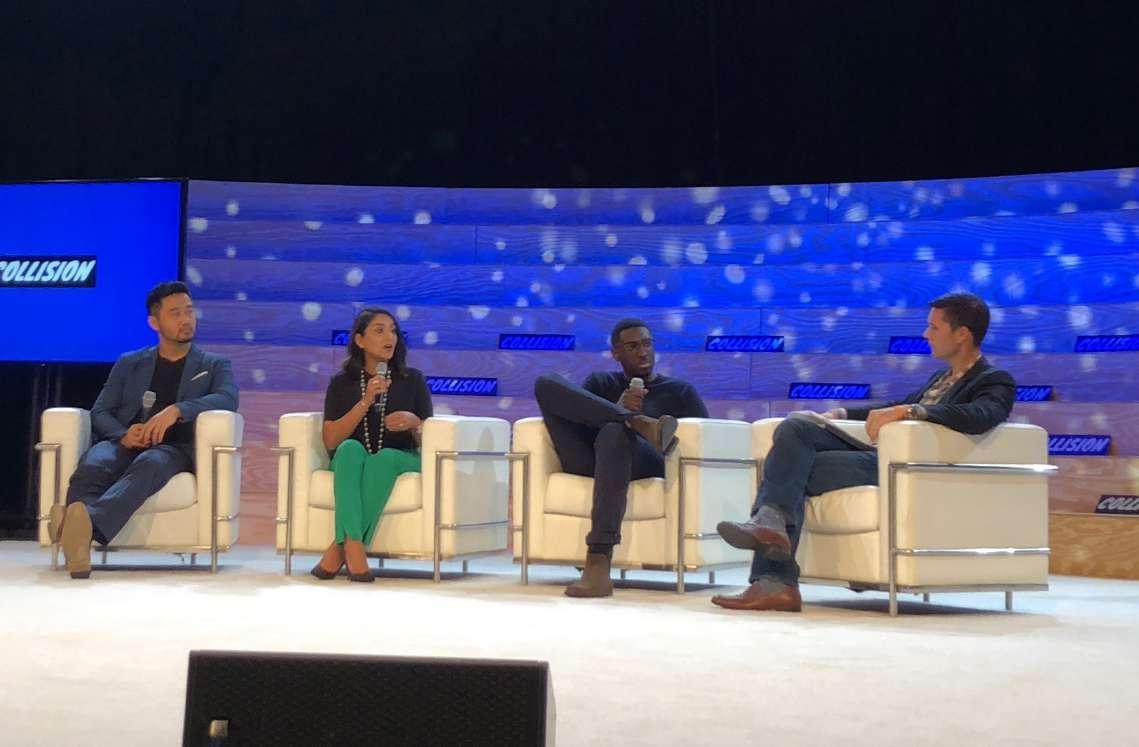
There were internal demons to vanquish, too. She had to wrestle with her own apprehensions, self-doubt and the impostor syndrome. Even with family support, she was still unsure about starting something on her own.
“My first challenge was myself,” Madhani said. “The biggest hurdle to get over was my own fear. Once I let go of it and thought, what’s the worst that’s going to happen? I’m going to fail and being okay with failure and accepting failure. To say, it’s actually not failure, I’m going to gain experience. I think that was a big mindset shift that I had to make. That was like the first lesson.”
Being in Orlando, far from Silicon Valley, was another challenge for a nascent company trying to raise capital. And then Madhani was recently
Suneera Madhani holding her own at a panel discussion
• You don’t need a seat at the table, you don’t need any fancy degrees, you don’t need to be the smartest person in the room.
• What you can do is get about what you know - your product.
• Focus on what makes you unique, your product unique.
• Cultivate and find people around you that really complement the things that you don’t have.
• Build an amazing team around that supports you and your vision in areas that you are not great in.
• Don’t be afraid to ask for help. Raise your hand, ask for help and own your story.
• As a woman, you’re constantly going to be told that you can’t do something. You have to believe harder than anyone, that you can.
• So shut out the noise, stay focused and go get it.
married, with her first child on the way, and working between her first two rounds of funding.
“I was just experiencing it firsthand. So me being a woman out of Orlando, a Pakistani, and raising capital. When I look back, it was all stacked against you,” she recalled.
The young Madhani took refuge in her father’s mantra and confidence of her own business idea. The biggest lesson she learned was that men got investments based on their potential, and women for what they had already done.
“Lucky for them, I had done incredible things and our business was growing in leaps and bounds,” she said. :Our demand was high, our technology was wonderful, we were doing an excellent job and were outpacing the industry.”
Business is personal for Madhani. She treats her company like her first-born and takes care of it like she does her two daughters. Her passion for her company is so intense that she refused a lucrative acquisition offer in the early stages that even her board was really excited about. After all, the offer was for more than the value of the raised capital at that time.
“It was the best decision that we ever made,” said Madhani. “Our value went from that amount, which I believe was 17 million at the time, to over $1 billion. So it was the right call.”
Madhani encourages others like her through her podcast, “CEO School.” One of the top 100 podcasts in the U.S., it focuses on female entrepreneurs. The only male guest featured so far is Faisal Madhani, her husband, who is also an entrepreneur.
They met in college and have been together ever since. Though he plays no formal role in Stax or “CEO School,” he has been a rock for her, Madhani said.
“He is my best friend, my life partner and the world’s greatest dad,” she said. “Somebody who loves my family, probably just as much if not more than I do. He’s the one that always encourages me to keep shooting for the moon. He is also a very confident man. It’s hard to stand next to a woman who is always in the spotlight.”
Under Madhani’s leadership, Stax now boasts more than 270 employees and earns $100 million+ in recurring software revenues. But there’s more to her than just business.
“I’m a mother. I’m a wife. I’m a daughter, I’m a sister, I’m a philanthropist. I’m an author. I’m a podcast host, I’m a CEO,” she said. Admittedly, being a mother tops the priority list.
“I know that God made me a girl-mom for a reason,” Madhani said. “I have two little ones. My eldest just started first grade. They’re growing so fast. Being a mother is like probably the greatest title I wear.”
“THE SYSTEMS ARE DESIGNED FOR WOMEN TO FAIL. SO YOU’RE UP AGAINST A GIANT HURDLE ALREADY, REGARDLESS OF BEING A SOUTH ASIAN OR NOT. LESS THAN 1% OF CAPITAL GOES TO MINORITIES IN AMERICA. SO THERE’S DEFINITELY A HUGE DISPARITY IN THE WAY THAT WHITE, MALE STARTUPS ARE TREATED.”
an intrinsic part of Diwali celebrations, has changed over time, with new age ingredients replacing traditional ones. However, the celebrations remains true to their origins.
Given the complexity of the meal, it is a good idea to choose recipes you can prepare in advance to store, reheat, and serve later. Remember, the festival is a time to spend quality time with your family and loved ones rather than spending long hours cooking and sweating in the hot kitchen.
“You may also prepare paan aur gulkand ki kulfi well, or paan shots to aid digestion after a heavy festive meal,” says Reetu Uday Kugaji, a culinary expert and chef consultant. “Incorporate a lot of seasonal fruits or vegetables. The simplest ingredients make the most delectable dishes. You
don’t always need exotic ingredients. Go local, seasonal, organic, and sustainable.”
Diwali is when the Indian community, friends and families tend to come together.
“It is important to pay attention to what we are consuming on these festivals, especially calorieloaded sweets,” says Tarun Panjwani, application chef, Middle East, Fagor Professional, at the Onnera Group. “We must make a healthier choice while preparing desserts. In fact, not just desserts, we should innovate by adding healthy ingredients to our entire occasion menu. While it is difficult to say no to festive delicacies, and we don’t have to completely let go of our favorite treats, we should just swap them with something healthier.”
So here is a “healthier” three-course meal for you to try this Diwali.
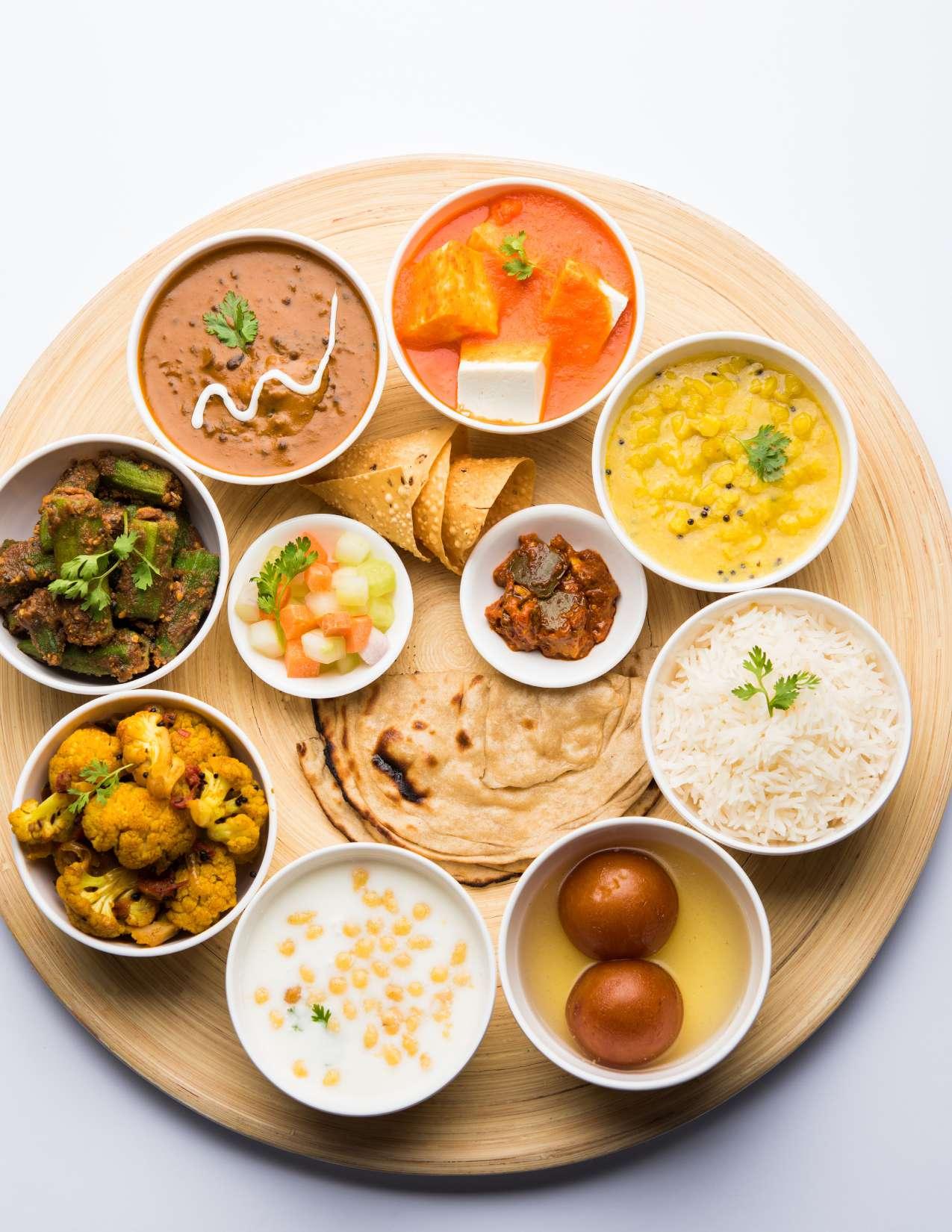

This is a very popular recipe I serve at my SONA . It is Inspired by the one the very popular winter chaat dishes from the streets of Delhi. Crisp Japanese sweet potato cubes tossed with sumac chaat masala spice mix, pomegranate seeds and drizzle of creamy yogurt, date syrup and spicy green chutney will be a standout side dish and a star of the dinner table.
• 2 medium-sized sweet potatoes
• 1 cup potato starch (or cornstarch)
• 1 tsp chaat masala
• 1 tsp sumac
• 1 tsp roasted cumin powder
• Black salt (to taste)
• Chili powder (to taste; optional)
• Oil as required to fry
• 1 tbsp date syrup
• 1 tbsp spicy green chutney
• 1 tbsp whipped sweetened yogurt
• 1 tsp lemon juice
• Fresh pomegranate pearls, baby greens for garnish
1. Put the potatoes in a large pot and cover with cool water by an inch. Heavily season with salt and bring it to a simmer over medium heat. Cook for 25 to 30 minutes, until the potatoes are fork tender. Drain the potatoes, peel, and set them aside until they are cool enough to handle but still warm.
2. With a fork, gently break the potato apart into
pieces about two inches in size. Add the pieces to a large mixing bowl and toss with 1 cup of potato starch, evenly coating all slides. Dust off excess starch. It is important that the potatoes are still warm. The residual heat helps the starch coat the potatoes and ensures a very crisp outer coating when you fry the potatoes. Let it cool on a sheet pan in a single layer in the refrigerator for at least an hour.
3. Make the chaat spice mixture. Mix in chaat masala, sumac, cumin powder, black salt, and chili powder in a small bowl and whisk everything together until they are evenly combined. Set aside.
4. To fry your potatoes, heat oil in a large heavybottomed pot over medium-high heat until it reaches about 360 degrees Fahrenheit. Then, working in batches to avoid overcrowding, fry your potatoes for 3-4 minutes, until they are golden brown and crisp. Set them in a large mixing bowl and toss with half of the spice mixture. Repeat the process until all your potatoes are fried and spiced.
5. Arrange the seasoned potatoes on a serving platter and drizzle with date syrup, spicy green chutney, and yogurt. Garnish with pomegranate seeds and herbs and greens of your choice.

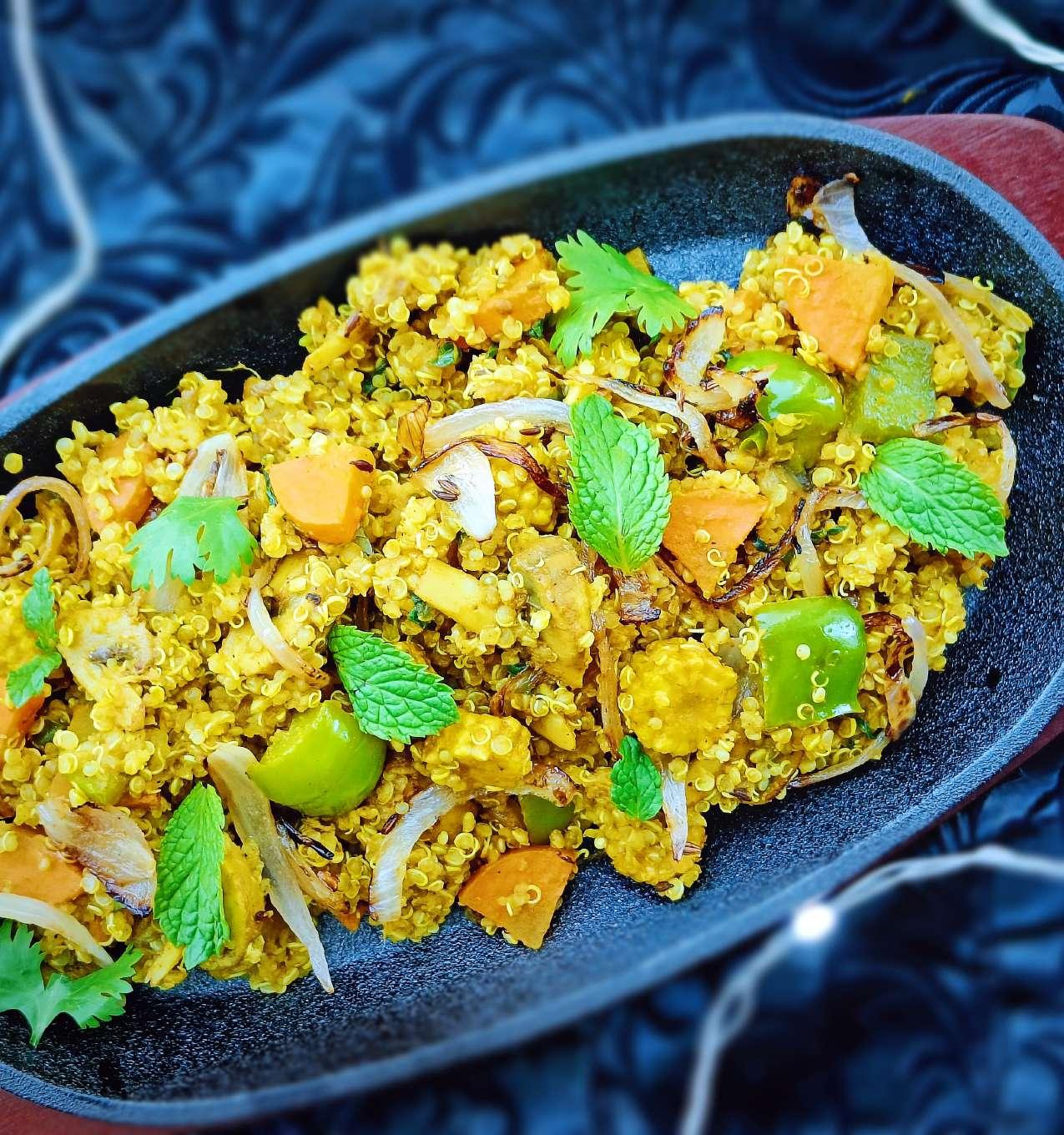

Biryani is an emotion, it has many forms, it connects people, it is such a treat which we always prepare on special occasions like these festivals. I have added a special healthy twist to my biryani recipe by replacing rice with quinoa, it is a wonderful seed, not a grain and perhaps one of the most popular superfoods.
• 1 cup quinoa, washed and soaked
• 1 red onion, sliced
• 2 green chillies, chopped
• 3 white mushrooms, sliced
• 3 baby corns, sliced
• 1 carrot 1, diced

• 1 bell peppers, diced
• Mint leaves for garnish
• Coriander leaves for garnish
• 1 tsp cumin seeds
• 1 bay leaf
• ½ tbsp coriander powder
• 1 tbsp biryani masala
• ½ tbsp turmeric powder
• ½ tbsp red chili powder
• 1 tbsp garam masala
• 1tbsp salt
• Kewra water optional (available on Amazon)
1. Cut assorted vegetables as per your choice – bell peppers, baby corn, mushrooms,
carrots, snow peas.
2. Wash and soak one cup of quinoa for one hour.
3. Place a boiling pan with water.
4. Once the water boils, put quinoa and let it boil for 15 minutes.
5. Add oil to another nonstick heavy bottom pan.
6. Add bay leaf, cumin seeds, green chilies chopped, sliced onions and sauté it.
7. Once the onions are browned, reserve some and keep them for garnish.
8. Now in the same pan, add all the veggies and cook them on medium heat,
9. Add the powdered spices – biryani masala, coriander powder, garam masala, turmeric powder, red chili powder and salt.
10.Now add fresh, chopped mint leaves.
11.Keep a check on the quinoa; once boiled, drain it completely and transfer it into the biryani pan.
12.Layer the quinoa and mix it generously with the veggies.
13.Check the seasoning, drizzle kewra water if you like to, and cover the dish with lid and let it cook for 10 minutes,
14.Garnish it with fried onion, mint, and coriander leaves.
15.Serve hot with plain yogurt or raita.
It is creamy, rich, delectable, and smooth like silk halwa prepared with puree of corn kernels, slow cooked in vegan ghee, sweetened with coconut sugar, goes in loads of slivered nuts and raisins, mildly flavored with green cardamom powder, laced with vegan chandi ka warq, and topped with slivered nuts
• 2 bhuttas (corn on the cob) with the husk removed and
• ½ cup corn kernels, pureed
• 2 tbsp vegan ghee / vegetable oil
• 2½ tbsp coconut sugar (more or less as desired)
• ¾ cup water / almond milk
• ¼ tbsp almonds, slivered
• ¼ tbsp pistachio nuts
• ¼ tbsp raisins
• ¼ tsp green cardamom powder
• ½ sheet vegan silver leaf (chandi ka warq) (available on Amazon)
• ¼ tbsp almonds, slivered
• ¼ tbsp pistachio nuts, slivered
Shave the bhutta (Corn on the cob) to get only the kernels.
1. Blend the corn kernels into a smooth purée / paste.
2. In a heavy-bottomed pan add and heat vegan ghee / vegetable oil.
3. Add the corn and cook for two minutes over a high flame, ensuring that you stir it continuously.
4. Lower the flame to a medium heat, cook the paste and stir occasionally for another 15 minutes ensuring that it does not burn or stick to the bottom of the pan.
5. Once the ghee starts oozing out of the corn paste add hot / lukewarm water / milk.
6. Be extra careful at this stage as the halwa has the tendency to splutter, you may cover it with a lid, and then open and stir till a little water is absorbed.
7. Add the coconut sugar and green cardamom powder. Mix well.
8. Let the sugar melt completely. Once the halwa thickens and the ghee oozes out, switch off the flame. Serve very hot in dessert bowls, laced with vegan silver leaf and garnish with slivered almonds and pistachio nuts.

Add saffron strands, if desired.
Do not add too much of flavorings as it might mask the delicate flavor of bhutta.

Thefood and beverage industry has begun experimenting with traditional food to give it a new age contemporary twist, whether in terms of ingredients, presentation or cooking methods. The result is a set of innovations that produce plates full of sweet surprises.
Traditional sweets in India are usually laden with sugar and ghee and other ingredients heavy on the palate. However, traditional sweets are changing to remain relevant in modern times. One example is the baked
gulab jamun, a modern take on a traditional dessert that can also be made without oil and without being dunked in sugary syrup. Instead, healthier sweeteners are used: jaggery from sugarcane, palmyra, date palm, honey and different kinds of dates. Also, these sweets use natural flavoring, eschew artificial additives, and come in recyclable boxes. Keeping the taste true to its origins, sweets are getting an artisanal makeover. So you have a motichoor ladoo in wine, lavender and elderflower flavors, as well as cheesecake in the form of a barfi.
According to Shwetha Rajashekar, COO of India Sweet House, “Over the last one year we have seen a huge wave of nostalgia hit the market along with people becoming equally conscious about how and what they consume.
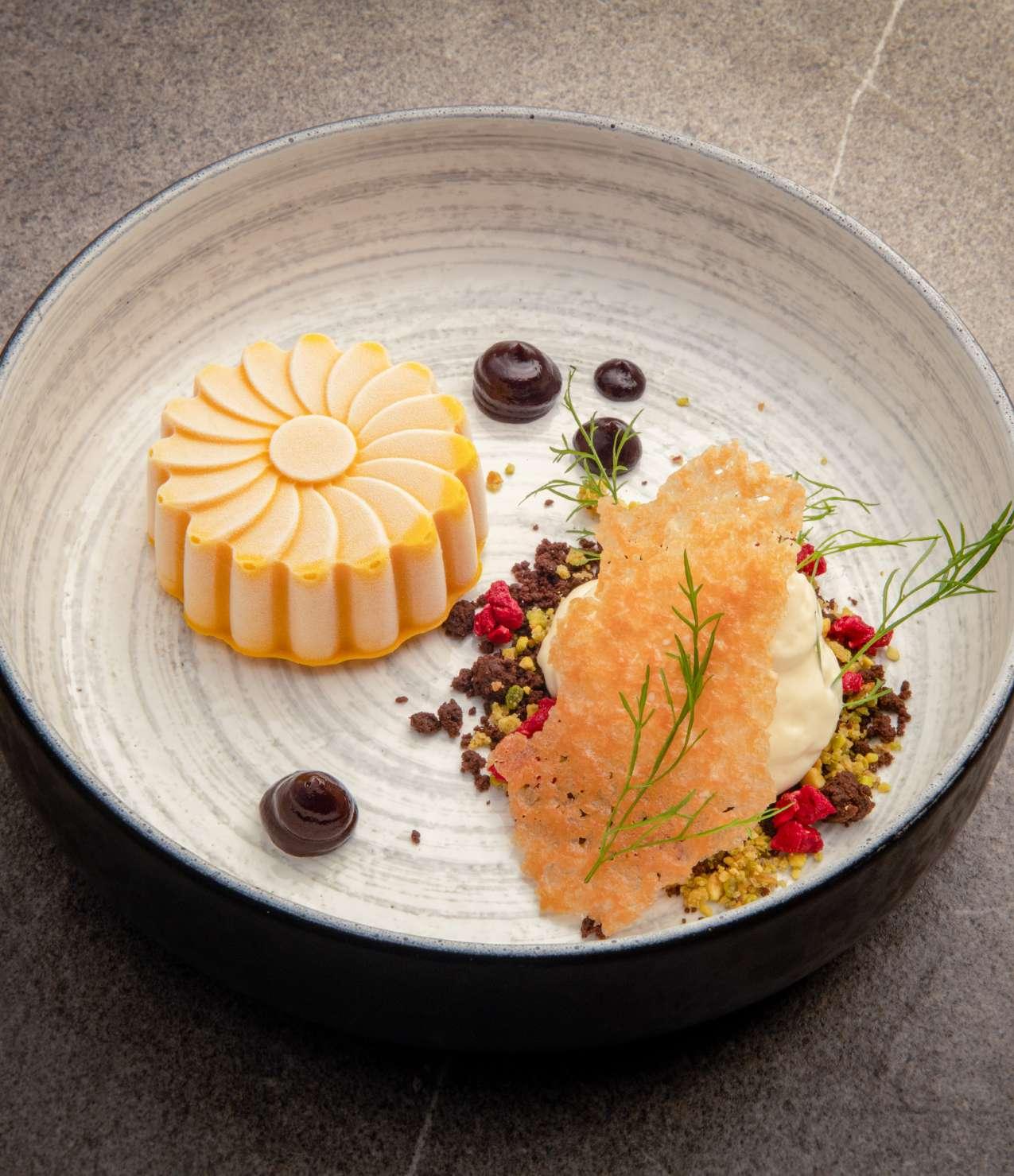

This has led to the revival of a lot of lost recipes made from the purest of ingredients grown with sustainable practices. This has received an overwhelming positive response.”
This is what Chef Hari Nayak, who currently helms the kitchen at Priyanka Chopra’s restaurant, Sona, does as well. Nayak came to America in 1996 to go to a pastry school and learn to make French pastries and chocolates.
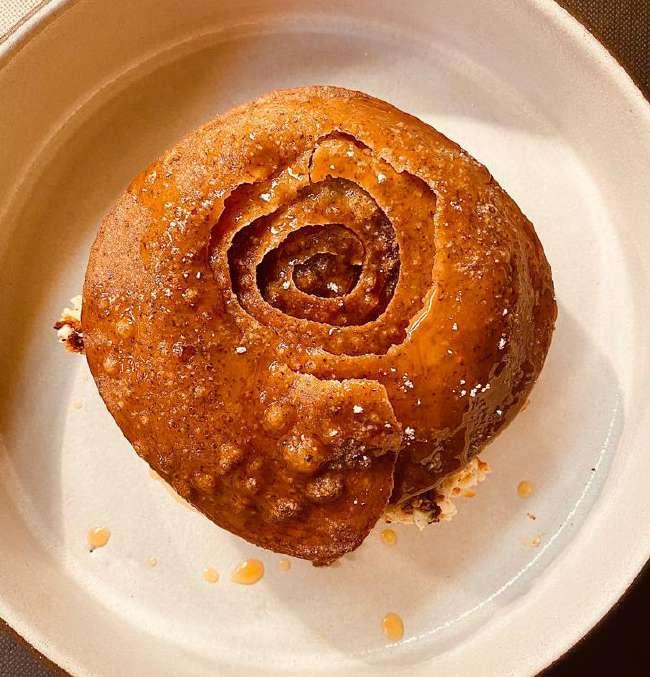
“After my course, I got into a pastry kitchen but soon realized that, as an Indian in a French kitchen, it was not working out for me,” he said. “Many years later when I started developing menus for restaurants, I started using European pastry techniques with Indian sweets. Growing up in Udupi, I have never really been a fan of north Indian sweets as I found them very sweet for my taste. I liked local sweets like holige [akin to a sweet chapati] that were never too sweet.” He started developing Indian sweets with French influences.
“I make gulab jamun creme brulé that replaces the sugar syrup. Even my menu in Sona has chiroti (a flaky, crispy pastry) made from buckwheat flour, which I have realized makes it crispier. I use thin layers served with cheesecake and bourbon ice cream. In the season we serve it with caramelized apples,” says Nayak. Chiroti, of course, is being used as a medium of crunch in the dish but adds a great taste profile.
Nayak also makes a pear Jalebi with jaggery and poached pears. Even the ghewar and rabri from Rajasthan has undergone a makeover at Sona: it is served with ghewar
and cheesecake.
“I like to give the Western audience what they are familiar with, with a little bit of India. For Indians, they also like it as it gives them something that they are familiar with. Even in Alchemy [a restaurant at Hotel Chancery Pavilion] in Bangalore we crumble Mysore Pak and make a baked cheesecake with it,” says Nayak.
Most of our sweets are not desserts, but celebratory (or otherwise) bites to be enjoyed at any moment of the day. Given current meal patterns, and everyone’s effort to reduce the intake of sugar, one has to move them towards the end of a meal.
“The effort to elevate our sweets into Western-style desserts began back in the 90’s (when fusion cooking was at a high point),” says Ashfer Biju, executive chef and director, food and beverage, at Perrine NYC. “Creating sweets and Indian desserts with locally available and new(er) or unusual ingredients is in vogue. For example, Chef Vittal Shetty in California makes an unbelievable raspberry ladoo and a delicious beet burfi as part of his mithai collection in Xari foods sweets. “Chefs are taking popular Indian desserts and sweets and making them in their kitchens from scratch, adding their twist to it, and presenting them as they would otherwise present Western desserts. No cheesecake there, but just a perfect ghewar, possibly combined with rose petal kulfi and plated on a coupe plate, with a gold tuile.”
While many traditional Indian sweets have not changed, some chefs make their own interpretations.
“I do think what’s changed is that chefs are being inspired and putting their own spin on these desserts,” says Maneet Chauhan, award-winning chef, author, television personality, and founding partner and president of Morph Hospitality Group in Nashville, TN. “For example, I do a version of the traditional carrot halwa and make carrot halwa whoopie pies, which is a homage to where I have come from and where I have ended up. Another example of this is our gulab jamun cheesecake served at Chauhan Ale & Masala House, which is made with traditional gulab jamuns that’s modernized by using it in cheesecake. The end result is so good.”
So, this festive season, when you are looking for desserts to make or buy, consider going for the twist of taste and see how it lights up (pun unintended) your taste buds.
Filmmaker Kaveri Kaul helps her locate her ancestral home in India
ABHIJIT MASIHFatima Sheikh, who went to rural West Bengal to locate her grandfather’s village
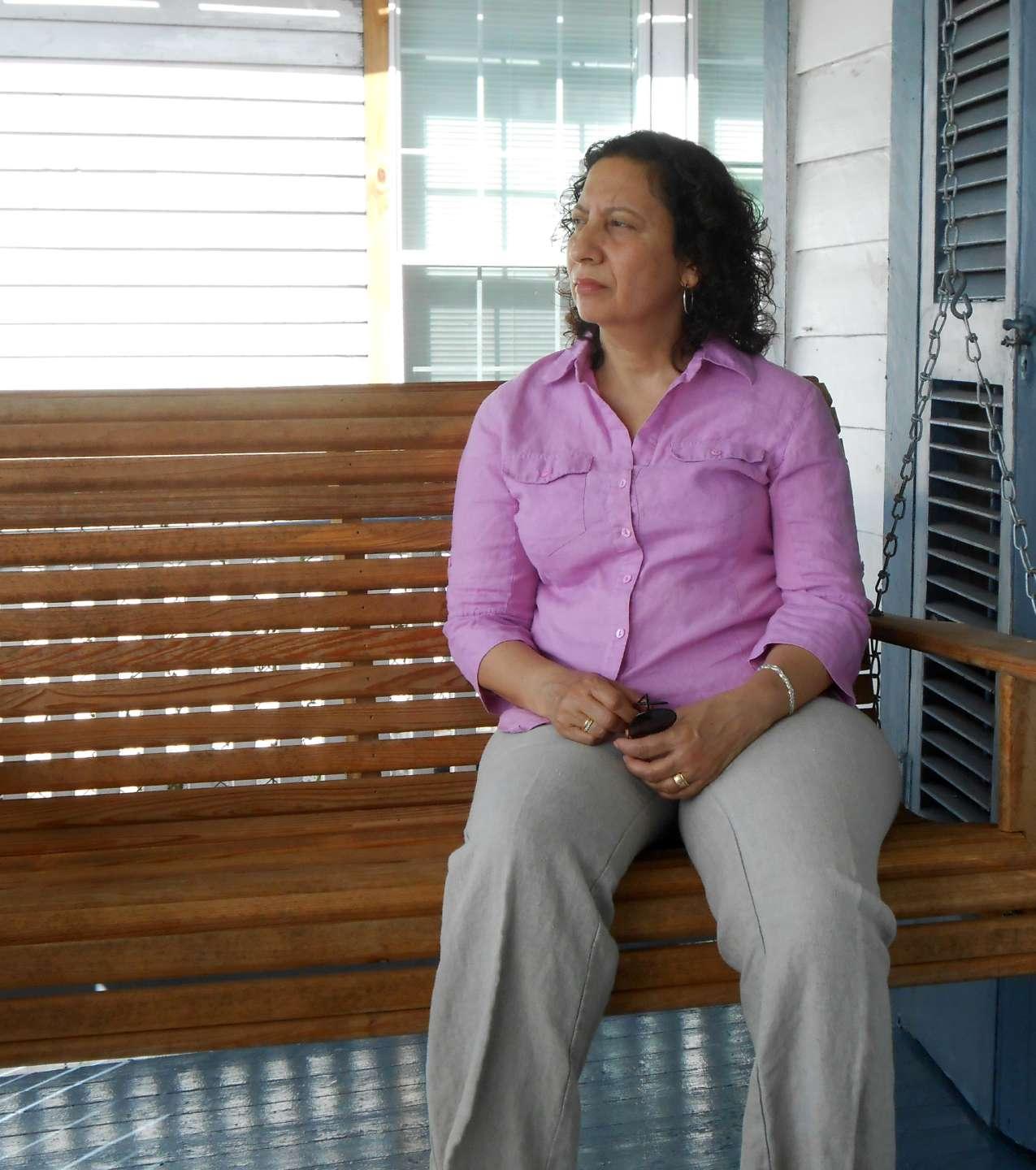
How does Fatima, an African-American Catholic woman in New Orleans, have facial features, skin color and even a mole on the same spot on the nose as Ilyas, a Muslim villager 9,000 miles away in India?

The African American writer has lived in New Orleans all her life and continues to carry her grandfather’s name – Sheikh. The family has lived in Louisiana for four generations. But the story behind the name goes back to her grandfather, an Indian who traveled to the U.S. in the late 1800s.
Fatima’s moving and fascinating story reflects the ties between South Asians and African-Americans in the U.S. going back to the late nineteenth century. Like her grandfather, Sheikh Mohammad Musa, the newly arrived men from India married African-American women. While we witness black and brown immigrant populations pitted against each other today, the reality as we learn, is somewhat different. South Asians and African American populations in the U.S. have a long history of meaningful associations, just like the one between Sheikh Musa from Bengal and Tini (Fatima’s grandmother) from Clairborne Avenue in New Orleans.
Fatima and her family always knew that they were different from the other members of the African American community. She talks about her Indian lineage and how and when she came to know about her grandfather being Indian.
“I can’t remember a time when I didn’t know that. My family always talked about him being from India, but we weren’t sure where he was from India. I talked about Sheikh Muhammad Musa, because we looked a little different from our neighbors. New Orleans was so obsessed with color and race and that sort of thing. So there was a need to explain to your children, where they were from and who they were.”
A chance meeting of Fatima with Kavery Kaul, an award-winning director, producer, and writer led into a conversation about the common Indian co
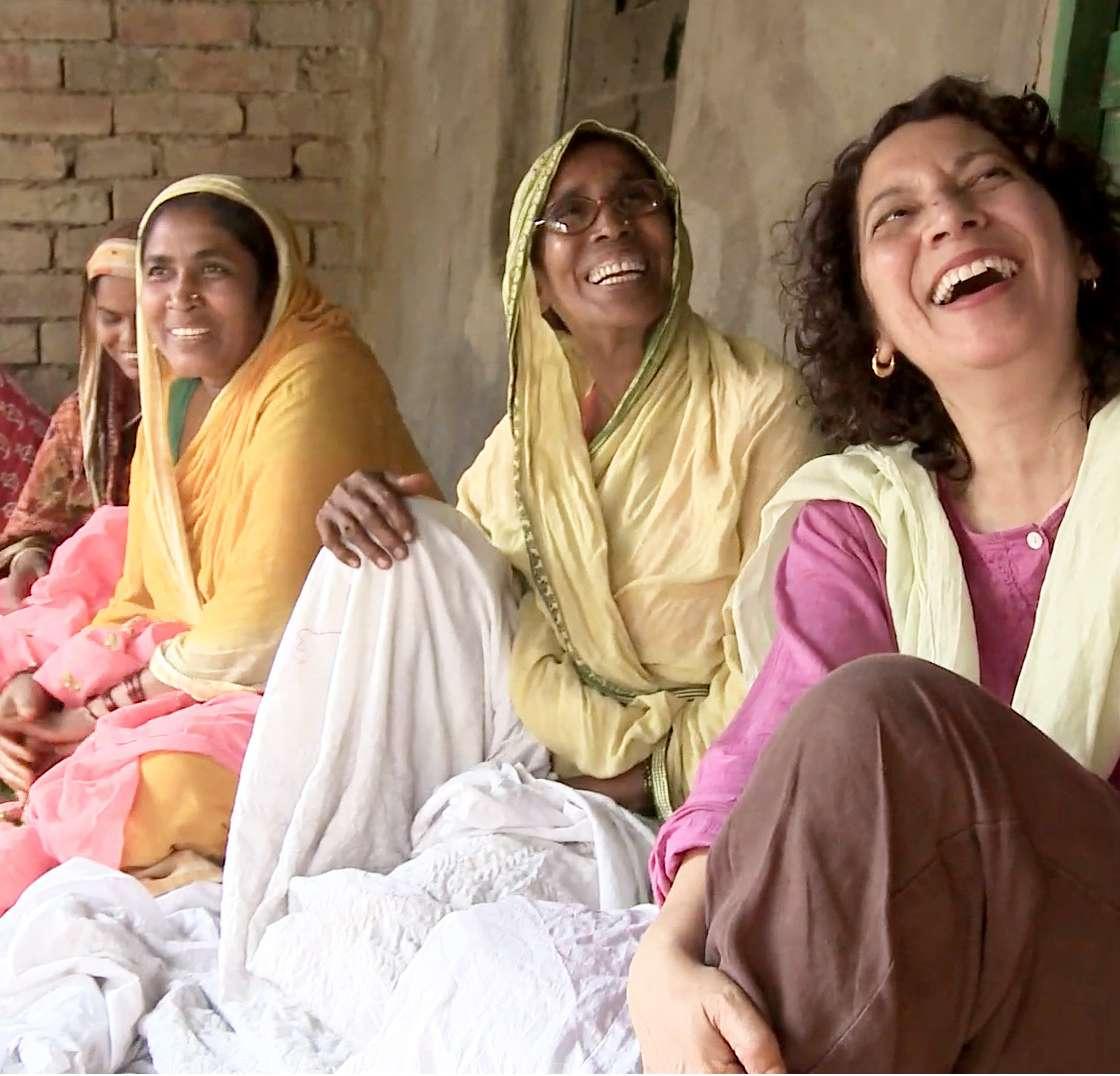
that bound them together. Intrigued by her story about Sheikh Musa and learning about Indians that had come here to America long before she and her parents came to the country, Kaul decided to make this into a feature documentary.
“The Bengali” blends form and content to forge a dynamic work of creative nonfiction. She along with Fatima sets out on a somewhat impossible quest, traveling from New Orleans, the city of her Fatima’s birth, to India, home of her grandfather Sheikh Mohamed Musa.
The filmmaker talks about meeting Fatima and what drew her to the story of Sheikh Musa, “When I first met Fatima, I saw her as the rest of the world sees her as an African-American woman, rooted in that community in New Orleans,” Kaul said. “Then she mentioned to me that her grandfather came from India. That triggered a lot of memories for me, because my
mother had always told me that people did come from India long before we did. She was a history teacher. She told me, you’re not going to find it in the books, but I hope you find out more.”
The chance meeting between the two sets the stage for creating trust between very different communities and through the documentary attempts to showcase the journey of finding your roots, reconnecting to a place after almost a hundred years. It tries to shine light on the significance of the personal story, memory and myth surrounding her grandfather.
Sheikh Musa passed away before Fatima’s father was born, so there wasn’t much information available about her grandfather other than a few photographs that her aunt showed her and the only heirloom that they possessed of him was a hookah. Even that sole piece of treasured belonging perished during the devastation of Hurricane Katrina. Fatima talks about her grandfather.
“My grandmother was like two or three months pregnant, when his father died, so he had never met his father, and his sisters were, I think, like three and six years old,” she said. “So they didn’t really have any long lasting memories either. I can’t remember anything from when I was a child but my aunt came up with the photographs now. I don’t know where she found them. But she found the photographs of him and gave us more proof.”
To think of taking this journey to India in the hope to find the place of a person who left more than a century ago with so little information would have been considered harder than finding nirvana. The film traces the journey an African-American woman from New Orleans took across deep divides of culture to India in search of her family’s past. It evokes the richness and wonder of families stretching across time and place, looking for where they come from.
Armed with the knowledge that Sheikh Musa came from Bengal and perhaps owned a piece of land, disclosed via a letter written by him to a lawyer in Kolkata, Fatima and Kaul traveled to the city in India. A region where knowing the local language is a must, it was a boon for Fatima to have Kaul, who was born in Kolkata and knew the language, to spread the word through her contacts and to put the missing pieces together.
Kaul credits her passion for filmmaking, which she described as a blend of passion and insanity, to help her.
“I knew I wanted to reclaim this history in a meaningful way, with a story that brought it up to date and made it about today,” she said. “I didn’t know
“I THINK IN NEW ORLEANS THE NEIGHBORHOODS ARE SELF-CONTAINED AS WELL. MANY OF THEM EVEN MORE SO WAY BACK THEN. I THINK WHAT TIES THEM TOGETHER COMES FROM THE TEXTURE OF LIFE. FOOD IS IMPORTANT IN BOTH CULTURES – CUISINE AND HOSPITALITY.”
if we would find where she came from, but for me as a filmmaker, that was part of the story. I went not knowing what we would find and very interested in seeing the stories that Fatima and her family have grown up with, turned out to be true for them. I could not have found the village without the help of everyone in Kolkata and outside. Basically, I did it the old Indian way, I spread the word. I was very, very grateful because no one said, I am crazy.”
Through information gathered from friends and connections they got to know that Sheikh Musa actually was from a remote village not very far from Kolkata, a village not even mentioned on the latest maps. The two women with their small film crew reached the small village by asking directions from people on the road. Khory, with a largely Muslim population, had never seen an American before and received the inquiring foreigners with a mix of hospitality and suspicion.
Overwhelmed with emotion, Fatima shares her feeling to have finally found the birth place of her grandfather, walking under the same trees, in the same fields that probably her grandfather might have walked a century or so ago.
“It was very sentimental and actually felt very spiritual to me,” she said. “I felt that there was a common spirit. I also felt a little sad that my father didn’t live to see it. That really would have been a wonderful thing for him and his sisters.”
Though she is a Bengali herself and has been there
many times, Kaul spent six months there before she started filming. She talks about the difference between meeting people on holiday and in the course of work.
“Having tea there on a visit is not the same as sitting down and having tea over a project,” she said. “Or checking out the different spots in the city for the light of that moment, because I was looking at it from a filmmaker’s point of view. And so all of that happened over time.”
The filmmaker also points out a few similarities between the people she filmed in the urban city of the deep American south and a remote South Asian village in rural India.

“Khory is a remote interior village, not far from Kolkata, but its remoteness keeps it very self-contained as a community,” she said. “I think in New Orleans the neighborhoods are self-contained as well. Many of them even more so way back then. I think what ties them together comes from the texture of life. Food is important in both cultures – cuisine and hospitality. Those are the similarities and qualities between African American culture and Indian American culture.”
For Fatima, it was a moment of closure for her and for her family. To find the true story about Sheikh Mohamad Musa, which till now had been floating around as myth within the family. To find Indian relatives, descendants of her grandfather’s sister. To find Ilyas, her distant cousin, who like her has daughters and an identical mole on his nose.
 RASHMI GOPAL RAO
RASHMI GOPAL RAO
Oftendubbed as the most beautiful season of the year, autumn is a lovely transitional season from summer to winter. It is a time when temperatures start to dip, leaves change color and nature’s landscape is a treat for the senses! It is also a time to bring out those cozy rugs, blankets and of course the chrysanthemums, pine cones and pumpkins. Whether it is lanterns, wicker baskets, hints of copper or hues of yellow and ocher, decorating for autumn is all about bringing in those comforting, inviting vibes to make your home your sanctuary. So, here are some ways you can decorate your living room for the upcoming fall season.
Since the living room is one of the most
used spaces in the house, it is important to remember that any changes to the décor should balance aesthetics and functionality.
“One does not require a lot of redesigning when it comes to fall-inspired home décor,” says Misbah Kapadia, founder and curator of Design Konstruct. “This design style is all about simplicity, wooden elements, natural materials, and creating a snug and reassuring atmosphere. Swapping accessories around the house, using dry flower arrangements in vases and adding a few accessories is a good start. Rugs, wooden and metal lamps can be added in the living room along with patterned cushions to enhance aesthetics. Cane baskets placed over a console give a complete [aesthetic] look of the room and can be used for storage.” Apart from cushions and rugs, you can also accentuate your furniture with loose knitted throws.





“Well-upholstered armchairs with an ottoman by the fireplace is an ideal fall setup,” says Sonali Pandit, senior architect, Aum Architect. “The corners and nooks of your living area can be given a new look for the season using accessories like macrame wall hangings. Cotton and woolen throws are great ideas to add texture and volume.”
Fleece, linens and brushed cotton add a warm texture apart from furnishings with plaid patterns, floral and botanical prints.
Autumn is all about a vibrant color palette with orange, yellow, red, and brown being classic autumn hues. Along with this, shades like coastal blue, quetzal green, and martini olive make your space look cheerful and bright. “A mix of minimal and modern textile prints in gorgeous burnt orange with bold black and white works well as a quick and easy autumn upgrade,” says Abhishek Chadha, CEO and founder, The KariGhars. One can add several elements in varying to make the room look more dynamic. “Choose accessories like a trunk, a tray, candles, leather clad books etc. along with some simple flowers and lanterns. Assemble them into vignettes and you are ready for the new season,” adds Kapadia.
Adding a few fall-themed artifacts like faux pumpkins, pine cones, fresh seasonal flowers, and an autumn wreath can instantly open up your space for a breezy autumn spirit. “The living room’s center table can be used create simple arrangements without going overboard. It can include a basket of fresh harvest with candles on either side or a simple display of branches or dried flowers. To

establish the mood for the season, adding an autumn message as framed art to your living room is a good idea too,” says Chadha.
Apart from artifacts and accessories, it is key to note that lighting plays a vital role in creating the right ambience in the living room.
“Since evenings can get dull and gloomy in the fall, installing appropriate lighting fixtures in your living room is of utmost importance. Always opt for soft lighting. A fireplace brings warmth and coziness which works well for the cold weather outside. You can opt for candle holders to add depth to your fireplace and create more visual attraction” says Robin Sisodiya, founder and principal architect, ASRO Arcade India. Infusing aromas like cinnamon, pumpkin spice or sandalwood in a diffuser helps enhance the serene ambience.
The essence of any seasonal themed décor is to keep things simple and not overdo things.
“A common mistake while implementing fall décor is creating an overly themed space,” says Pandit. “Apart from subtly introducing the colors of the season, layering and proportions are the vital factors of décor. Balance taller elements like dry flowers with shorter candles and finally a shallow tray filled with potpourri. Use plenty of weathered wood, dull gold and copper accents, colored glass, yellow lights and indoor plants to give your space a quick make over.”
“Do not use anything flat, bright or shiny,” says Sisodiya. “Look for soft faux fur blankets to add to your sofa or accent chairs to get a plush and cozy vibe. A table lamp and floor lamp are enough to create a welcoming atmosphere.”
Whenyou think of Diwali, what’s the first word that comes to mind? Is it diyas lit in every corner of your home? Is it the aroma of savory goodies in the kitchen? Is it the sight of mithais — a sight for sore eyes? Is it the new clothes, jewelry, puja, gatherings, card session, rangoli or something else that brightens you up during the festival of lights?
With the pandemic, for two years in a row, many of us didn’t get to celebrate Diwali on a scale that we might have been used to. I am on big on festivals, whipping up a few traditional recipes, and gathering with loved ones. My mom taught me that only if we are fortunate are we able to celebrate a festival. She meant it in terms of health, wealth, and support. Mom

This Diwali, be your own light and light up someone else’s lifeSweta Vikram is an author, speaker, and ayurveda-based health and mindset coach
thought of festivals as a way of celebrating humanity and saying gratitude to the universe and God.
In these two years of missing festivities — what we grew up taking for granted — we have all had the time to reflect and recalibrate. I am a thinker at heart, so I wanted Diwali to become even more meaningful than what the Vedic texts and generational hand-me-down traditions tell us. Every year, we do so many things on autopilot mode. But do we pause to think that Diwali truly represents the healing power of love and light? It’s celebrated on the darkest day of the year. The agni in the diyas is associated with transformation in Ayurveda. It’s pure and it has the power to illuminate the darkest corners of the human heart and world.
In our home, aside from lighting up diyas for puja and our NYC apartment, I started lighting up five intentional Diwali lamps.
• One for my mom who taught me to love all festivals with zest.
• One for the loved ones who passed away.
• One for the babies born during the pandemic. I realized that we were so focused (understandably) on the losses starting 2020 that we forgot to acknowledge the lives we welcomed.
• One for my yoga and Ayurveda community — teachers, teachings, students, colleagues, clients, and friends: they light up my inner agni.
• One for the people who remind us that good will always win over evil.
Start your own traditions that bring your family and friends closer together. Be creative. Maybe make a rangoli together as a family from scratch and let that be your tradition? Maybe your family comes together for Choti Diwali and cooks a one-dish meal and shares that with your neighbors? Be intentional about lighting up diyas together.
I know a large majority of people reading this are already conscious about what they feed their bodies. You might choose to spend an extra hour running, practicing yoga, lifting weights, or swimming — you get my drift — the day after Diwali. I won’t tell you to
pay attention to what you feed your body. I’m going to urge you to be mindful of what you feed your soul this Diwali and how you choose to spread the light. Can you recognize that your helpers have less than you? Can you sponsor a lunch for your helper’s family around Diwali? Would you consider volunteering time, not money, for organizations that feed the hungry? Do this as a family activity. Will you smile and compliment three people in your community? I don’t mean fluff; genuine things that you like about them.
We live in a world which is filled with opposing views, arguments, varying philosophies, and a lot of pessimism. Social media gives people the permission to hide behind masks and say hurtful words. We judge, criticize, and become distant from authenticity and attached to materialism. Who throws the bigger party? Who has the better sari collection? Which host got totally wasted? What the world needs is a little more kindness, patience, and compassion this Diwali. For Diwali, we clean up our homes and paint the walls. I urge you to look within and let go of what doesn’t serve you. We all have shades of darkness within. Is it food addiction, alcoholism, lethargy, social media obsession, over-expressionism, procrastination, infidelity, extreme competitiveness, bad mouthing others etc.? Pick your vice and let it go. Maybe do a social media detox for two evenings the week of Diwali? We get so busy sharing moments on the Internet for external validation that we forget to enjoy people and moments present right in front of us. I urge you to get together as a family and share (individually) what each person is grateful for. Dig deep within. On Diwali, 2020, I said, “I am grateful to have my breath.”
What good is external sanitization and house cleaning on Diwali if your insides are rotting and relationships are suffering? What good is a vibrant décor in your house if your inner diya feels dim? Be your own light and be the reason for lighting up someone’s life this Diwali. If there is one thing that the pandemic has taught us: life is fragile, so don’t squander it mindlessly.
“You cannot celebrate the festival of light before combating the darkness within.”
Backwhen most of us reading this were growing up, we didn’t have books with characters like us. We often had to fit our round selves into the square “conventional” pegs of Anglo-centric, heteronormative stories we read or heard. While mainstream media is abuzz with conversation about diversity, equity and inclusion, children’s media still has a long way to go in terms of containing stories that South Asian children and young teens can see themselves in. So whenever a book falling in this category comes out, we at SEEMA are thrilled.
Whether it’s portraying the festivals they celebrate at home or the color of their skin, children need to recognize themselves in the books created for them. When parents share these books with their children, they co-create a world their kids feel a part of. These days, fortunately, more and more authors are filling this gap.

In “Dream Like Me,” trailblazing football coach Manisha Tailor profiles 42 pioneering individuals working in all parts of English professional football–from male and female players to coaches, referees, board members, administrators, sports scientists and medical staff – representing different cultures and faiths within the British Asian community. These powerful stories not only illustrate the challenges faced by these role models, but lessons that they can offer young readers. “I want them coming away not only learning about how [someone] got into media, but also the fact that to maintain a positive mindset, they keep a gratitude journal and how it helps,” says Tailor, the only British South Asian woman in a coaching position in the English professional game. Each story also comes with comprehension questions that allow kids to sit and reflect on the stories they read and what they can learn from them.
We’ve picked out five super-interesting books for children that have come out recently or are coming out soon. They feature children from all walks: a boy falls in love with his grandmother’s saris, a young girl celebrates Diwali in the states for the first time. Teenagers talk about their passion for football. These books make for excellent bedtime reading.
When little Leila’s mother gets sick, many things change for her family. But one crucial thing stays the same: they still have each other and know how to find joy and laughter when they need it most.
Sheetal Sheth wrote “Making Happy” while undergoing chemotherapy. “I wrote [the book] when I was looking for books for my young children when I was in treatment,” she says. With gorgeous illustrations by Khoa Le, the book brings a sympathetic and poignant perspective to the story of how a family copes with a mom’s cancer diagnosis through a young girl’s point of view

In a tale of self-exploration, a Tamil boy explores his love for his grandmother (Paati) and her colorful sari collection. As he goes about doing some fun activities in preparation for a party; the boy finds comfort in Paati’s sari, whether he’s wrapped in its colors for dress-up or clutching its folds for comfort. Each sari holds a story that speaks to him.
“My Paati’s Sari” commemorates how clothing can convey tradition and individuality and connect us to our families and ourselves. With lively prose and dazzling art, this genderdefying book explodes with color as it narrates the tale of a young boy’s journey to self-discovery.


When young Yousif Tlaib asks about his mom, Rashida Tlaib’s new job in Congress, his older brother, Adam, fills him in. As he tells his mom’s story, Adam discusses how elections and government work, what it means to break barriers, what motivates their mama to work for justice for all, and how love and family have guided them through this historic time in our country. In this way, the book also provides an early introduction to civic engagement and how the government works.
From becoming the first in her immigrant family to graduate from high school to eventually becoming one of the first Muslim Congresswomen and an influential national figure, Tlaib’s inspiring story shows kids that they, too, can do great things and make a difference.
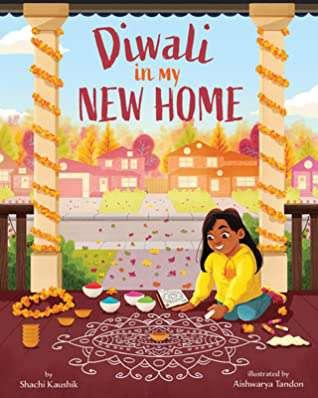
“Diwali in my New Home” is the story of Priya, a girl who loves being with family and friends to celebrate Diwali. But Priya and her parents began living in the United States this year, and no one seems to know about the holiday. Priya misses the traditions in India. As she strings lights and creates rangoli art, Priya introduces the festival of lights to her neighbors. And even though the celebration is different this year, it’s still Diwali.
This picture book for children ages 5-8, speaks to Indian children’s new experiences living abroad after they’ve lived in India.

doesn’t love a road trip? Whether it is planned, right down to where you fill gas, the last detail, with room for unplanned detours and stops?
Sometimes even more than the joy of reaching a destination on your bucket list is the exhilaration of driving through scenic roads, with breathtaking views and tranquil landscapes unmarred by toll booths, road rage and or traffic accidents.
For most, summer is the best time to take off on road trips, since that is when the school breaks. You see the maximum number of RVs and trailers on the road then, most of them headed for beaches or national state parks. While it’s nice and green everywhere,
the journey tends to be monotonous and boring, no matter how many winding roads you travel through rolling hills or ocean-view drives.
Now imagine driving through those very same routes in the fall. A single lane road, meandering through a forest on a hill, trees on both sides presenting a guard of honor dressed in myriad colored uniforms, forcing you to ease on the pedal to savor the beauty. The weather allows you to roll down your windows, open up the sunroof and be one with nature.
If that is not enough to convince you to head out, then perhaps you will find a spectacular route in your state, close to home, that could tempt you. There is at least one such route in every state. Here are some of the most fascinating road trip routes to take in the US during fall.

Tucked away in northern California is this relatively short stretch of route that packs in much seasonal beauty. The Everitt Memorial Highway in California is only 14 miles long but takes you up the southwest side of Mt. Shasta, a volcano that towers over 14,000 feet. The 14-mile drive could be done in an hour or take you all day. Absolute gorgeous views of Mt. Shasta overlooking the Sacremento valley brimming with the colors of fall will keep you there for the day. In terms of activities, there is something for everyone for outdoor lovers. If you live in the Bay Area, for you this should be on top of the list of things to do this November, with just over 4 hour drive up North.

This scenic 130-mile route is located in the Pinelands National Reserve and takes you through the classic Pine Barrens forests along wetlands, rivers, unique villages and important historic sites. The byway is home to and popular for its vast natural and cultural treasures. The route tempts you to slow down, explore and experience one of the best and most unusual natural environments. For breathtaking fall foliage in New Jersey, consider starting the journey in New Gretna and go all the way to Hammonton. To get a taste of the local culture, make a stop at the Batsto Village to check out the historic iron-making community. The cranberries of Chatsworth are worth a stop as well to complete your day. About an hour from Philadelphia and less than that from Trenton, it’s a fabulous day trip destination. If you live in the area and haven’t done it already, do it during fall.

Route 97 is one of the best fall drives in the country. It stretches for 70 miles from the village of Hancock to Port Jervis, and offers breathtaking views of both the Catskills and the Poconos. The byway offers recreational opportunities for lovers of the outdoor, these including boating, camping, hiking and cycling. Just over two hours away from New York City, this is a great way to get away from the on-the-go life of the big city and rejuvenate in the shelter of nature. The byway winds around the Delaware River, which also forms a natural state line between New York and Pennsylvania. This is perchance the best and closest drives for tristate dwellers, and should well be on the itinerary for one weekend in fall.

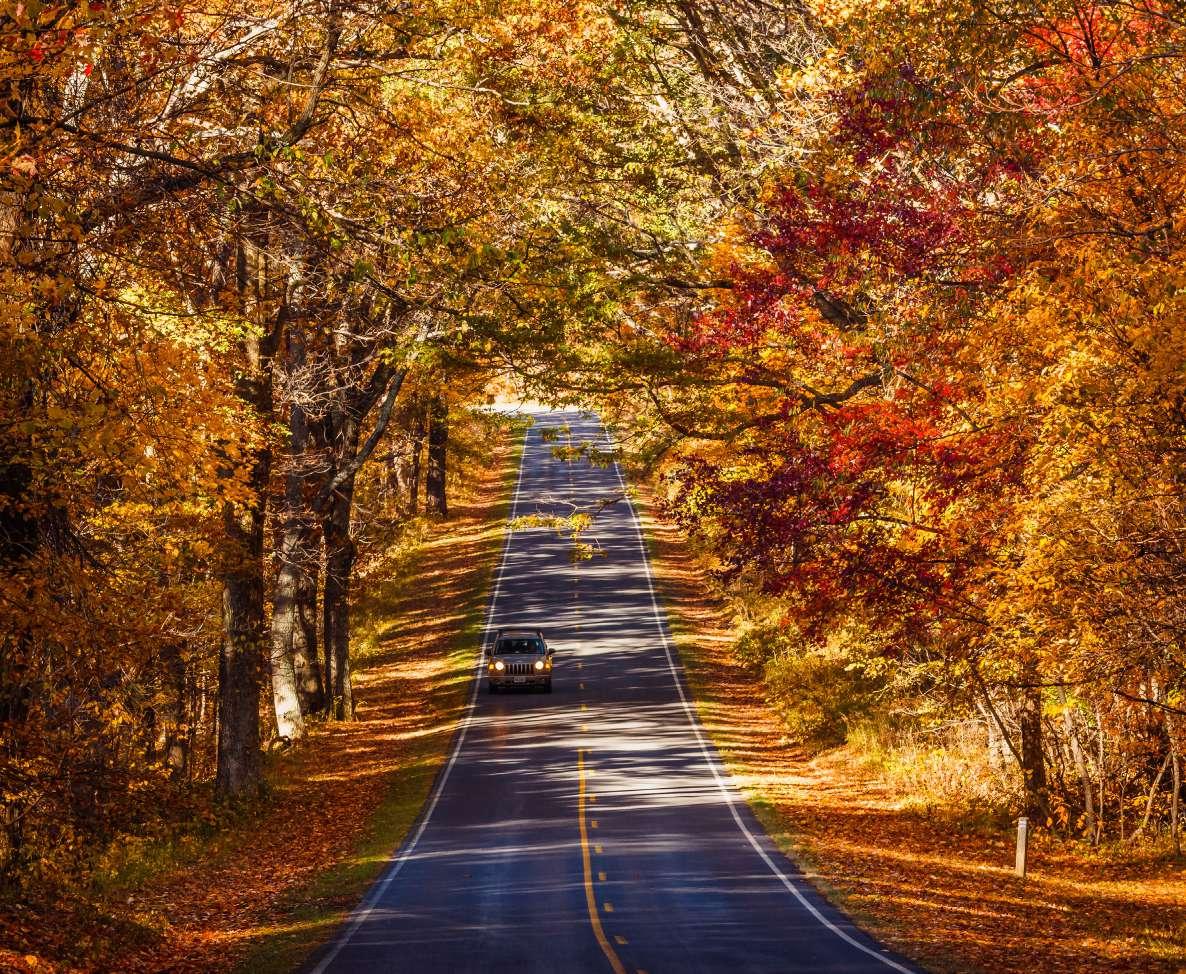
About two hours’ drive from Washington D.C., the Skyline Drive is one of the most beautiful drives in the country, snaking around the Blue Ridge Mountains in Shenandoah National Park. The 105-mile elevated drive offers mesmerizing landscapes and is littered with lookout points. You are spoiled for choice where to take in the spectacular sunset from any of these points perched atop the Appalachian Mountains. The aptly named Point Overlook is my favorite overlook point for
sunset-watching. The speed limit of 25 lets you navigate the pathway under trees turning into every shade of yellow and red imaginable during fall. You could also get off the drive and make a pit stop to experience the wonder of the Luray Caverns, the largest in eastern United States, with large chambers filled with limestone stalactites, stalagmites and columns. If you live in the D.C. metro area, this should be on top of the list of things to do before winter.
You may be forgiven to believe that Texans don’t experience fall. Perhaps it comes a little later than other states. You may not see it in the southern regions of the state but in the northern parts you may get the best viewing of fall colors in Texas. The Pineywoods Autumn Trail that stretches for 145 miles offers magnificent fall colors. The popular trail that begins in Palestine takes you through the Texas Forest Trail Region and ends in Athens. The scenic drive between these two cities offers breathtaking views and has multiple attractions, including local wineries, outdoor expeditions, train excursions and zipline adventure. The best time to go is mid- to late November.
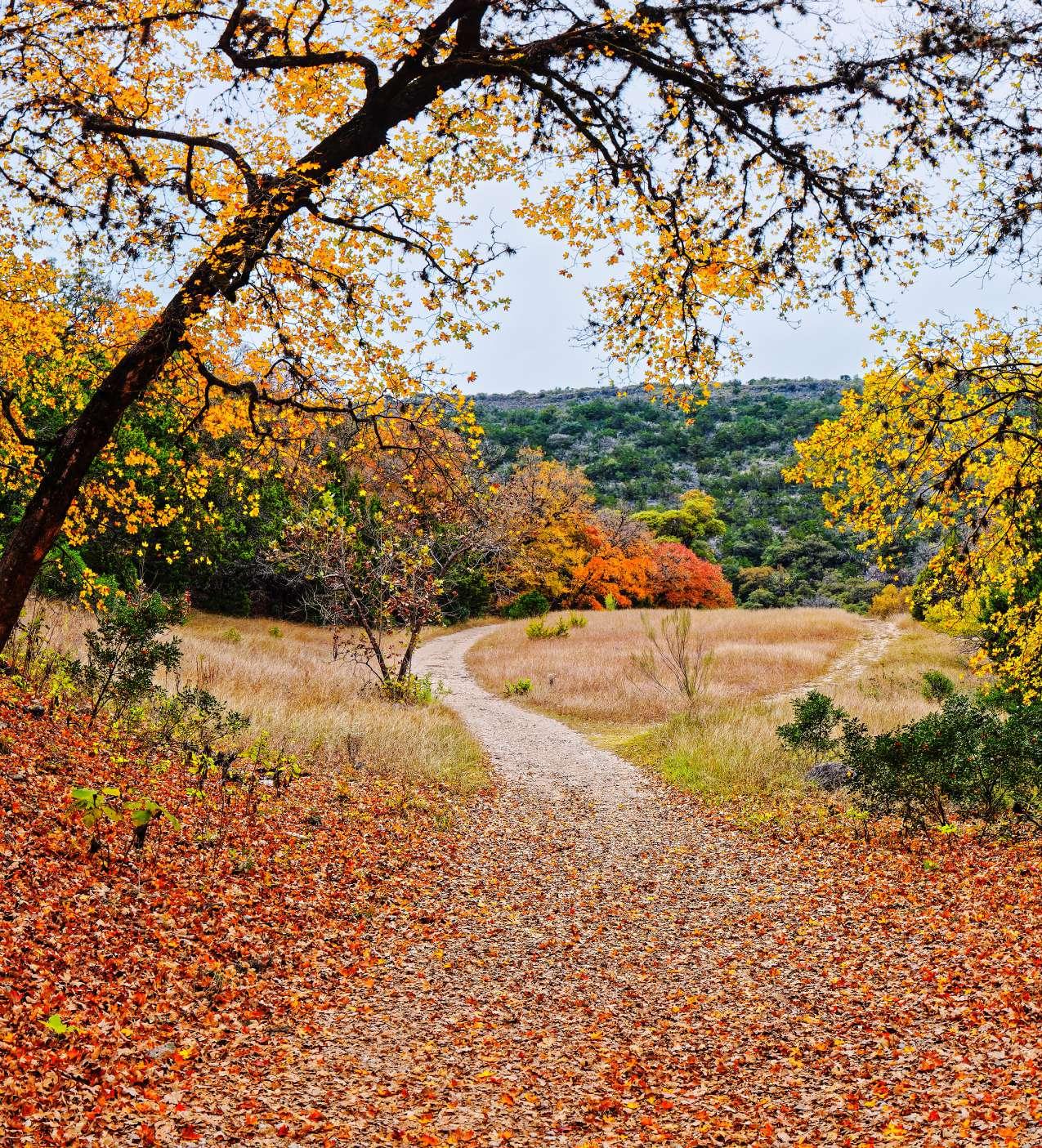
The Cascade Loop Highway offers 440 miles of uninterrupted scenic leaf-peeping opportunities. Arguably the best road trip route in Washington, it covers a large part of the state. It offers the diverse landscapes of Washington, all within state lines. There are many stops along the Cascade Loop that are must-sees in their own right, including a string of beautiful lakes, rivers, forests and mountains. Coupled with the opportunity to experience the untamed wild, the highway is an unforgettable road trip destination. As recent as January 2021, the U.S. Department of Transportation designated it a National Scenic Byway. Take a drive here to appreciate the many different shades of gold, coral and red.


Cotswolds is a region in

Theuniversity town of Oxford was my base to explore the Cotswolds.
One breezy summer morning, I embarked on a tour of the famed villages with Ian, who runs small group tours into the inner recesses of the Cotswolds, designated as an Area of Outstanding Natural Beauty, spread across five English counties (Wiltshire, Gloucestershire, Oxfordshire, Warwickshire and Worcestershire).
“The name actually comes from an Anglo-Saxon chieftain named Cod in the 12th century. He owned a vast expanse of ‘wold,’ or upland country, in this region. Hence, this was Cod’s wold and eventually became Cotswolds,” said Ian.
We had started early from Oxford and planned to drive through a couple of villages in Oxfordshire before reaching the Northern Cotswolds in Gloucestershire, the most picturesque part of southwest England.
The first stop was Minster Lovell, a pretty village. We walked by honey-colored buildings overlooking wellkept gardens brimming with summer blooms. A couple of vintage cars passed by, with cheery faces on the wheels. It was a Sunday and an unusually clear summer morning. At the northern edge of the tiny village, it was a short uphill climb surrounded by woodland, a river gurgling its way through it.
“This is River Windrush, and it has journeyed through history,” Ian announced dramatically. He pointed to the crumbled ruins of an ancient manor house, standing quietly beside the gushing waters. As we went through the entrance and marveled at the impressive remnant of the original vaulted ceiling and an ancient dovecote, Ian delved into the checkered past of the manor house of the Lovell family (from which the village derives its name). It is a chilling history set in the times of the Battle of the Roses in the 15th century. The lord of the manor got embroiled into it and lost his life in a secret vault inside this house. His skeleton was found nearly three centuries later.
“That makes this lovely hamlet one of the most haunted villages in England, with ghostly wails in the night around the manor house, that dates back to 1430,” Ian told us as our small group took a little hasty step back to the car.
Our next destination was Swinbrook, a short drive of 10 minutes from Minster Lovell. An idyllic village, a
pretty church, a cricket pitch with a wooden pavilion and an ocher-hued stone pub beside an arched bridge across River Windrush that trickles by. The setting looks so incredibly vintage that the popular TV series “Downton Abbey,” a historical period drama set in the early 20th century, was largely filmed there.
Burford, dubbed the “gateway of the Cotswolds” was barely 10 minutes’ drive from Swinbrook, but could be a world away from it. The long high street set upon a hillside and flanked with antique shops and funky cafes characterize the medieval market town that was the hub of the booming wool trade for more than half a millennium. The 12th century town church is the oldest building in Burford. In its moody, dimly lit interiors the graffiti and carvings made by prisoners (it was a temporary prison in the mid-17th century) still survive. When we came out into the sunlit churchyard, Ian showed us the age-worn tombstones with a curious rolled design.
“These were bale tombs of the wool merchants of the era, unique to this part of the world,” he told us.
The medieval town of Stow-on-the-Wold was our next pit stop. The teeming town square, hemmed in with honey-colored buildings, tiny tearooms and bookshops belies the bloody chapter of history etched in its annals.
In the early spring of 1646, this market square was the setting for the last battle of the English Civil War, in which King Charles I’s army were defeated by the Parliamentarians. We wandered through the narrow streets, took a quick tour of the town church – an architectural wonder with its beautiful tree-framed doorway and stained-glass windows – before planting ourselves on the wooden stools of Porch House. With its rippled flagstone floors, low-beamed, skewed ceilings and yellowing frames on the walls, the traditional British pub whips up oodles of quirky character. I almost choked over my tankard of ale when Ian, sitting on the next stool, quietly told me that an inn on this site has been operative since 947 AD, which makes the Porch House the oldest pub in England!
Out of Stow-on-the-Wold and once more we were on the windy country roads, rolling green meadows stretching out on both sides. Shortly, we arrived at Lower Slaughter. A small stream wedges its way through the heart of this picture-perfect village. We walked its quiet left bank, marveling at the 16th and 17th century limestone homes with mullioned windows and gabled roofs. At the end of the village, the redbrick water mill dates from 19th-century, now housing a museum,
A taste of home awaits you in Chipping Camden and Cheltenham, two prominent market towns in the Cotswolds, where a couple of restaurants rustle up fine Indian cuisine from different regions. The chicken tikka curry at Maharaja Indian Cuisine is a lip-smacking affair, while Prince of India at Cheltenham serves authentic Bangladeshi cuisine.

The towns and villages feel like a time warp
Situated between the picturesque hamlets of Minchinhampton and Avening in Gloucestershire, Gatcombe Park is the country home of Princess Anne, and six miles south lies the late-18th century Highgrove House, the Cotswold residence of King Charles III.
The beautiful organic gardens are open to the public from April till October, with prior booking. The market town of Cirencester, reportedly a favorite with the royalty, dates back to the Roman times and buzzes with handicrafts, antiques and local produce.
Meghan Markle and Prince Harry had leased a lovely family home at Great Tew in Oxfordshire, where the 4,000acre estate perched in an idyllic bucolic setting has since been a major tourist attraction.
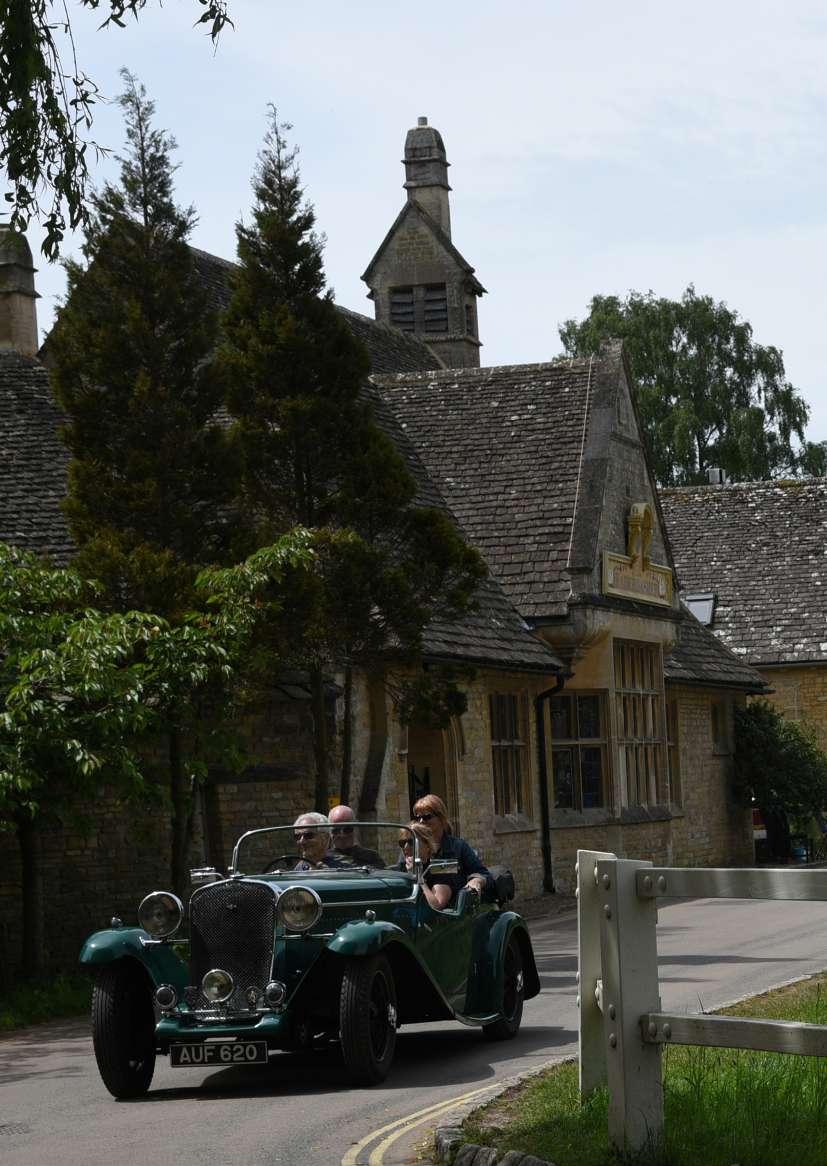
a gift shop and a café. But nothing in this charming Gloucestershire hamlet seemed remotely grisly, and I was expecting a gruesome tale of horror from the sound of its name! Ian explained that the name of the village actually comes off the archaic word “slough,” which meant a swamp!
We drove northeast for about half an hour and looped back into Oxfordshire for our final destination, Great Tew, arguably the most beautiful village in England. We got off from the car and immediately knew why.
Perched on a ridge, the village overlooked a beautiful wooded valley with clusters of dark red ironstone cottages fronted by rose gardens. The easy grace of the
horses ambling and tottering on the swathes of green completed the spectacle.
“This is not quite on the tourist radar because the narrow, winding streets are off limits to the large tour buses,” Ian said. The delightful driveway and the natural park were designed in 1808 by botanist John Louden and has remained unchanged till date.
The mellow afternoon sun glanced off the green Cotswold ridges, as we headed back towards Oxford. I had to catch a 6.35 am train to London, but had just enough time to find a quaint tea room and indulge in a traditional Cotswolds afternoon tea, served with freshly baked scones and clotted cream.


The time to step up to a new level of yourself is now. Embrace flexibility to discover new experiences. The only way to create new patterns is to take another route to learn, grow and thrive. Relationships require fresh orientation. Learn to forgive or apologize to obtain peace. Keep a check on the ego and you will find the gains, are worth it. Reassess your relationships, workplace situations and your financial status. To achieve victory, sometimes waiting is the best solution. Remember, you can’t push a wave onto the shore any faster than the ocean brings it in.
It is time to slow down, reflect and take a break from people and everyday life to light your own path. You are changing inside, and as that unfolds, it will lead to a new outlook and consequent behavior and priorities. Seek a mentor to help you process this phase. Let go of the past to declutter, drop and detox. Instead of being obsessed by material or spiritual pursuits, aim for balance.
Money may no longer be the oxygen that keeps your pulse moving, so go with the flow. In relationships, learn the virtues of stepping back to gain a new understanding of each other.

It is time to hit the ground running and focus your actions and energies on creating the abundant life you want. Don’t be afraid of change, embrace it. Remove the need for approval and pursue your goals – apply for a role you may not be qualified for or venture into a project you have never done before. Forward momentum is of the essence, go ahead and make your move. Things are likely to look positive in the love arena. Doors open for you, bringing opportunity on a personal, relationship or financial level. Be cautious in business situations. Your creativity and problem-solving skills are at a high, use them well.
It’s hard to say how things are stacking up. If the situation seems confusing, now; sit still instead of forcing your way into things before they are ready. If you are waiting on an answer from someone in a relationship, career or a financial decision, it may
take a tad longer than expected. Live in the present instead of worrying, unnecessarily of the future. There are no coincidences therefore focus on integrating and learning the lesson at hand. Look for patterns around your relationships. Follow your intuition about people and stay vigilant - best not to take people at face value. Be on top of your financial dealings.
You have what it takes to ride out the storms, gain the upper hand and reap the rewards you seek. Nothing will occur without effort and consistency on your part. Learn to make allies out of your obstacles, whether they be people or situations.
Stop running away from something that seems risky or painful and face it head-on. Communication is the secret sauce in your relationships. Don’t allow fear take the joy out of life. Just keep putting the little victories together.
You might feel the burden of responsibility too much at the moment and it may cause resentment. Take that extended hand or ask for help, for you are not alone. Remember, there is power and peace, in delegation. Expect changes that
drive you towards your inner strength. Be mindful of how and where you spend your resources. Nothing can stop you from achieving your goals so put the rubber to the road and get going. The possibility of a move – house, job or travel, is likely. Relationships may experience some strain due to the lack of or no communication. Be mindful about your health.
Embrace new beginnings, coming your way through new roles, ventures, assignments or a move. Begin implementing your plans and goals with optimism. Be open to new opportunities to create wealth. A new perspective in an existing relationship allows you to grow and learn from each other. If you are looking for love, don’t allow the grass to grow under your feet. Visualize your victory. If there was a time to manifest and create magic, it is now. Your creativity can yield positive outcomes. Avoid the temptation of being too controlling. You have access to everything right now, with the talent and skills you possess.
Stay true to your vision and keep your sights set on the plans you are most passionate about. Romance your dreams and make the future fall in love with them at first sight. Let faith drive your victory. Expect some news from abroad or a possible global opportunity. To those in an existing relationship, revive those courtship days and rekindle the
spark of love. And, if a relationship is no longer filling you up, it may be time to reevaluate its place in your life. Seek balance, patience and cooperation, not end results. Vet financial decisions and reign in the impulse to overinvest.

The journey of life is like the seasons. Each season prepares you to navigate through change, giving birth to something new. Grab the opportunity of a new project or act upon any new venture. Invest in learning, art and beautiful, ornate objects. If you feel somewhat bereft indulge in some self care. Listen to your instincts with respect to money. Relationships find comfort in deeper emotional engagement. Career potentialities open up when you step into yourself emotionally and rise above the superficiality around you. Align with yourself and who you are unabashedly. It is a busy time for travel, soirees and events.
Your conscience and common sense are coaxing you to do the right thing. Settle old accounts, take responsibility for your actions, and wait for the dust to settle. If someone has wronged you, prepare to be vindicated, publicly. You may receive crucial information to make the right decision in important business or financial matters. It is best to stay away from tempting quick money schemes; they come with karmic baggage. In relationships, it is a reminder to not settle for less than you deserve. In case you are at the end of a relationship,
legal recourse may be a possibility.


New beginnings, recognition, success, emotional stability and improvement in health and finances suggest a positive month. Expect something new from a career perspective. Keep an open mind. Aim higher. Go after what you really want and believe you’ll get it. Your currency is your authenticity. Don’t be surprised if you receive an unexpected bounty, a surprise gift, a scholarship or the possibility of some good news. Love is on the horizon for those looking for one. Hasty decisions will be the brakes that will prevent cash inflows and returns on investment.

If you have been busy getting things set for the future, this might be a good time to not lose track of your friends in all the plans you have. Enjoy the pleasures of life, and all the beauty this world has to offer. At work, you may collaborate with like-minded people on a creative project. If you have a habit of trying to keep everyone happy, try stepping back from feeling so indispensable. Look for opportunities to express yourself, be creative, and speak your truth within your love relationships. Celebrate your wins but remember to save up for a rainy day, too.
Farzana Suri is a Victory Coach who coaches people through their life’s challenges to take the leap to victory, using the science of numerology.
For a personalised forecast, you may contact Farzana at surifarzana@gmail.com or visit her website www.farzanasuri.com



